Variations in Pore Pressure and Effective Stress Induced by Wave and Current Around Monopile Foundations on Coral Reef Sloping Seabeds
Abstract
1. Introduction
2. Numerical Model
2.1. Wave Model
2.2. Seabed Model
2.3. Pile Model
2.4. Boundary Conditions
2.5. Computation Process
2.6. Numerical Model Validation
3. Numerical Model Setup
3.1. Computational Domain
3.2. Mesh Generation
3.3. Parameter Setting
4. Results and Discussion
4.1. Consolidation of Seabed Around Pile
4.2. Comparison of Slope and Flat Seabed
4.3. Influence of Slope Gradient
4.4. Influence of Wave Height
4.5. Influence of Current
5. Conclusions
- The validation results demonstrate that the developed model was capable of accurately capturing wave–current-induced pore pressure and effective stress around the monopile.
- The variation in seabed slope had minimal impact on the water surface amplitude around the pile but significantly affected the effective stress and pore pressure. In particular, the pore pressure on the lee-side of the pile showed the greatest sensitivity to the increasing slope, which weakened the bearing capacity and stability of the pile foundation. Moreover, the increase in slope increased the liquefaction depth around the pile, which was particularly obvious downstream of the pile.
- With the increase in wave height, the water surface amplitude upstream of the pile exhibited a greater increase compared to other regions. Additionally, larger wave heights predominantly promoted the development of effective stress in the z-direction, whereas the effective stress in the x-direction evolved more rapidly under smaller wave heights. Based on the variation in effective stress, the liquefaction depth also increased with the increase in wave height.
- The water surface amplitude upstream and on the lee-sides of the pile exhibited a nonmonotonic trend with increasing current velocity. In contrast, the water surface amplitude on both lateral sides of the pile decreased with the increase in current velocity and eventually approached a stable value. Furthermore, the effective stress, pore pressure, and liquefaction depth around the pile increased with the increase in velocity. Among the four observation points around the pile, the maximum vertical effective stress occurred on the lee-side of the pile.
- From an engineering perspective, this study holds significant practical value for the design and safety assessment of offshore structures situated on complex seabed topographies. On one hand, the research elucidates the underlying mechanisms by which sloping seabeds influence the dynamic response of foundations, thereby providing a theoretical basis for the layout and reinforcement design of monopile foundations in non-horizontal seabed conditions. On the other hand, the findings can be utilized to identify high-risk zones, thus contributing to the optimization of site selection and construction strategies for marine engineering projects.
Author Contributions
Funding
Data Availability Statement
Conflicts of Interest
References
- Bourne, D.G.; Webster, N.S. Coral Reef Bacterial Communities. In The Prokaryotes; Springer: Berlin/Heidelberg, Germany, 2013; pp. 163–187. [Google Scholar]
- Montaggioni, L.F. History of Indo-Pacific coral reef systems since the last glaciation: Development patterns and controlling factors. Earth-Sci. Rev. 2005, 71, 1–75. [Google Scholar] [CrossRef]
- Hopley, D. Encyclopedia of Modern Coral Reefs; Springer: Dordrecht, The Netherlands, 2011. [Google Scholar]
- Ye, J.; Shan, J.; Zhou, H.; Yan, N. Numerical modelling of the wave interaction with revetment breakwater built on reclaimed coral reef islands in the South China Sea-Experimental verification. Ocean Eng. 2021, 235, 109325. [Google Scholar] [CrossRef]
- Xiao, Z.; Song, L.; Li, J. Stability of the large cylindrical structures in Hong Kong–Zhuhai–Macao bridge: A case study. Appl. Ocean Res. 2020, 97, 102092. [Google Scholar] [CrossRef]
- Huo, S.; Zhu, M.; Dai, G.; Gong, W. Application of inclined steel-pipe piles in ocean engineering. J. Coast. Res. 2020, 103, 284–287. [Google Scholar] [CrossRef]
- Saengsupavanich, C.; Ferren, V.; Magdalena, I.; Ariffin, E.H.; Sanitwong-Na-Ayutthaya, S. Using piles for wave reduction and coastal protection: A review. Reg. Stud. Mar. Sci. 2024, 77, 103638. [Google Scholar] [CrossRef]
- Sumer, B.M. Liquefaction Around Marine Structures; World Scientific: Singapore, 2014; Volume 39. [Google Scholar]
- Jeng, D.S. Porous Models for Wave-Seabed Interaction; Springer: Berlin/Heidelberg, Germany, 2012. [Google Scholar] [CrossRef]
- Smith, A.W.S.; Gordon, A.D. Large Breakwater Toe Failures. J. Waterw. Port Coast. Ocean Eng. 1983, 109, 253–255. [Google Scholar] [CrossRef]
- Ulker, M.; Rahman, M.; Jeng, D.S. Wave-Induced Response of Seabed: Various Formulations and Their Applicability. Appl. Ocean Res. 2009, 31, 12–24. [Google Scholar] [CrossRef]
- Jeng, D.S.; Ye, J.H.; Zhang, J.S.; Liu, P.F. An Integrated Model for the Wave-Induced Seabed Response around Marine Structures: Model Verifications and Applications. Coast. Eng. 2013, 72, 1–19. [Google Scholar] [CrossRef]
- Manik, H.M. Acoustical Measurement and Biot Model for Coral Reef Detection and Quantification. Adv. Acoust. Vib. 2016, 2016, 1–11. [Google Scholar] [CrossRef]
- Yan, L.; Guo, X.; Zhang, X.; Qi, J. Numerical Simulation on the Frequency Response of 3-D Reef–Seawater–Seabed Coupling System Under Seismic Excitation. J. Mar. Sci. Eng. 2024, 12, 2343. [Google Scholar] [CrossRef]
- Biot, M.A. General Theory of Three-Dimensional Consolidation. J. Appl. Phys. 1941, 12, 155–164. [Google Scholar] [CrossRef]
- Biot, M.A. Theory of Propagation of Elastic Waves in a Fluid-saturated Porous Solid. I. Low-Frequency Range. J. Acoust. Soc. Am. 1956, 28, 168–178. [Google Scholar] [CrossRef]
- Biot, M.A. Theory of Propagation of Elastic Waves in a Fluid-saturated Porous Solid. II. Higher Frequency Range. J. Acoust. Soc. Am. 1956, 28, 179–191. [Google Scholar] [CrossRef]
- Zienkiewicz, O.C.; Chang, C.T.; Bettess, P. Drained, Undrained, Consolidating and Dynamic Behaviour Assumptions in Soils. Géotechnique 1980, 30, 385–395. [Google Scholar] [CrossRef]
- Jeng, D.S.; Rahman, M.S. Effective Stresses in a Porous Seabed of Finite Thickness: Inertia Effects. Can. Geotech. J. 2000, 37, 1383–1392. [Google Scholar] [CrossRef][Green Version]
- Yamamoto, T.; Koning, H.L.; Sellmeijer, H.; Hijum, E.V. On the Response of a Poro-Elastic Bed to Water Waves. J. Fluid Mech. 1978, 87, 193–206. [Google Scholar] [CrossRef]
- Madsen, O.S. Wave-Induced Pore Pressures and Effective Stresses in a Porous Bed. Géotechnique 1978, 28, 377–393. [Google Scholar] [CrossRef]
- Okusa, S. Wave-Induced Stresses in Unsaturated Submarine Sediments. Géotechnique 1985, 35, 517–532. [Google Scholar] [CrossRef]
- Sakai, T.; Hattori, A.; Hatanaka, K. Wave-induced transient pore-water pressure and seabed instability in the surf zone. In Proceedings of the International Conference on Geotechnical Engineeing for Coastal Development-Theory and Practice on soft Ground, Yokohama, Japan, 3–6 September 1991; Volume 1, pp. 627–632. [Google Scholar]
- Jeng, D.S.; Seymour, B.R. Response in Seabed of Finite Depth with Variable Permeability. J. Geotech. Geoenvironmental Eng. 1997, 123, 902–911. [Google Scholar] [CrossRef]
- Jeng, D.S.; Cha, D. Effects of dynamic soil behavior and wave non-linearity on the wave-induced pore pressure and effective stresses in porous seabed. Ocean Eng. 2003, 30, 2065–2089. [Google Scholar] [CrossRef]
- Chen, X.; Lei, Y.; Zheng, X.Y. Dynamic responses of a transversely isotropic poroelastic seabed subjected to nonlinear random waves with emphasis on liquefaction depth. Ocean Eng. 2023, 286, 115491. [Google Scholar] [CrossRef]
- Zhao, H.; Jeng, D.S.; Liao, C.; Zhu, J. Three-dimensional modeling of wave-induced residual seabed response around a mono-pile foundation. Coast. Eng. 2017, 128, 1–21. [Google Scholar] [CrossRef]
- Lin, J.; Zhang, J.-S.; Sun, K.; Wei, X.-L.; Guo, Y.-K. Numerical analysis of seabed dynamic response in vicinity of mono-pile under wave-current loading. Water Sci. Eng. 2020, 13, 74–82. [Google Scholar] [CrossRef]
- Lin, J.; Guo, Y. Numerical investigation of non-cohesive seabed response around a mono-pile by crossing wave-current. Water Sci. Eng. 2022, 15, 57–68. [Google Scholar] [CrossRef]
- Tong, D.; Liao, C.; Chen, J. Hydro-mechanical modelling of interaction between monopiles and cross-anisotropic sandy seabed subjected to wave loadings. Geomech. Geoengin. 2024, 19, 123–138. [Google Scholar] [CrossRef]
- Ye, J.; Jeng, D.; Wang, R.; Zhu, C. A 3-D Semi-Coupled Numerical Model for Fluid–Structures–Seabed-Interaction (FSSI-CAS 3D): Model and Verification. J. Fluids Struct. 2013, 40, 148–162. [Google Scholar] [CrossRef]
- Jasak, H. OpenFOAM: Open Source CFD in Research and Industry. Int. J. Nav. Archit. Ocean Eng. 2009, 1, 89–94. [Google Scholar]
- Liang, Z.; Jeng, D.S. A three-dimensional model for the seabed response induced by waves in conjunction with currents in the vicinity of an offshore pipeline using OpenFOAM. Int. J. Ocean Coast. Eng. 2018, 1, 1850004. [Google Scholar] [CrossRef]
- khumar Shanmugasundaram, R.; Rusche, H.; Windt, C.; Kirca, Ö.; Sumer, M.; Goseberg, N. Towards the numerical modelling of residual seabed liquefaction using OpenFOAM. OpenFOAM J. 2022, 2, 94–115. [Google Scholar] [CrossRef]
- Li, Y.; Ong, M.C.; Tang, T. A numerical toolbox for wave-induced seabed response analysis around marine structures in the OpenFOAM® framework. Ocean Eng. 2020, 195, 106678. [Google Scholar] [CrossRef]
- Qin, C.; Duan, L.; Wang, D.; Duan, B.; Fan, M.; Wang, H. Three-dimensional numerical simulation of wave-induced seabed response around a dumbbell-shaped cofferdam. Appl. Ocean Res. 2023, 134, 103501. [Google Scholar] [CrossRef]
- Li, X.J.; Gao, F.P.; Yang, B.; Zang, J. Wave-Induced Pore Pressure Responses And Soil Liquefaction Around Pile Foundation. Int. J. Offshore Polar Eng. 2011, 21, 233–239. [Google Scholar]
- Chang, K.T.; Jeng, D.S. Numerical Study for Wave-Induced Seabed Response around Offshore Wind Turbine Foundation in Donghai Offshore Wind Farm, Shanghai, China. Ocean Eng. 2014, 85, 32–43. [Google Scholar] [CrossRef]
- Sui, T.; Zhang, C.; Guo, Y.; Zheng, J.; Jeng, D.; Zhang, J.; Zhang, W. Three-Dimensional Numerical Model for Wave-Induced Seabed Response around Mono-Pile. Ships Offshore Struct. 2016, 11, 667–678. [Google Scholar] [CrossRef]
- Shi, F.; Dalrymple, R.A.; Kirby, J.T.; Chen, Q.; Kennedy, A. A Fully Nonlinear Boussinesq Model in Generalized Curvilinear Coordinates. Coast. Eng. 2001, 42, 337–358. [Google Scholar] [CrossRef]
- Lin, Z.; Pokrajac, D.; Guo, Y.; Jeng, D.s.; Tang, T.; Rey, N.; Zheng, J.; Zhang, J. Investigation of Nonlinear Wave-Induced Seabed Response around Mono-Pile Foundation. Coast. Eng. 2017, 121, 197–211. [Google Scholar] [CrossRef]
- Duan, L.; Jeng, D.S.; Wang, D. PORO-FSSI-FOAM: Seabed Response around a Mono-Pile under Natural Loadings. Ocean Eng. 2019, 184, 239–254. [Google Scholar] [CrossRef]
- Duan, L.; Jeng, D.S.; Wang, S.; Zhu, B. Numerical investigation of the wave/current–induced responses of transient soil around a square mono-pile foundation. J. Coast. Res. 2019, 35, 625–636. [Google Scholar] [CrossRef]
- Liang, Z.; Jeng, D.S. The instantaneous seabed liquefaction around offshore pile-type foundation and seabed protection under combined wave and current loading. Ocean Eng. 2022, 257, 111649. [Google Scholar] [CrossRef]
- Rafiei, A.; Rahman, M.; Gabr, M. Response and Instability of Sloping Seabed Supporting Small Marine Structures: Wave–Structure–Soil Interaction Analysis. J. Offshore Mech. Arct. Eng. 2022, 144, 032101. [Google Scholar] [CrossRef]
- Fan, M.; Lunliang, D.; Jianting, Z.; Zhuang, L.; Duoyin, W. Dynamic response of sloping seabed with buried twin pipelines under wave loading. Ocean Eng. 2024, 305, 117818. [Google Scholar]
- Lin, J.; Gao, Y.; Guo, Y.; Liu, J.; Feng, L. Wave-induced sloping seabed residual response around a buried pipeline. Mar. Georesources Geotechnol. 2024, 1–19. [Google Scholar] [CrossRef]
- He, K.; Ye, J.; Ma, L.; Fang, B. Seismic performance of revetment breakwater and nearby frame structure on reclaimed coral sand foundation in the SCS: Centrifuge shaking table test. Appl. Ocean Res. 2025, 157, 104512. [Google Scholar] [CrossRef]
- Ma, R.; Ji, B.; Zhang, L.; Pan, S.; Hu, K. Probability Stability Evaluation of Coral Reef Limestone Reef Slopes Under Earthquake. J. Mar. Sci. Eng. 2025, 13, 284. [Google Scholar] [CrossRef]
- Boussinesq, J. Theorie de l’ecoulement Tourbillant. Mem. Acad. Sci. 1877, 23, 46. [Google Scholar]
- Launder, B.E.; Spalding, D.B. The Numerical Computation of Turbulent Flows. In Numerical Prediction of Flow, Heat Transfer, Turbulence and Combustion; Elsevier: Amsterdam, The Netherlands, 1983; pp. 96–116. [Google Scholar]
- Matsson, J.E. An Introduction to ANSYS Fluent 2022; SDC Publications: Mission, KS, USA, 2022. [Google Scholar]
- Ashgriz, N.; Mostaghimi, J. An introduction to computational fluid dynamics. Fluid Flow Handb. 2002, 1, 1–49. [Google Scholar]
- Lee, H.C.; Wahab, A.K.A. Performance of different turbulence models in predicting flow kinematics around an open offshore intake. SN Appl. Sci. 2019, 1, 1266. [Google Scholar] [CrossRef]
- Otoo, E.; Asumadu, R.; Boadi, G.K.; Zhang, J.; Boadu, S.; Mattah, P. Numerical investigation of scour around monopile foundation of offshore wind farm. Discov. Appl. Sci. 2024, 6, 11. [Google Scholar] [CrossRef]
- Rusche, H. Computational Fluid Dynamics of Dispersed Two-Phase Flows at High Phase Fractions. Ph.D. Thesis, Imperial College London, London, UK, 2003. [Google Scholar]
- Brackbill, J.; Kothe, D.; Zemach, C. A Continuum Method for Modeling Surface Tension. J. Comput. Phys. 1992, 100, 335–354. [Google Scholar] [CrossRef]
- Vafai, K.; Tien, C. Boundary and Inertia Effects on Flow and Heat Transfer in Porous Media. Int. J. Heat Mass Transf. 1981, 24, 195–203. [Google Scholar] [CrossRef]
- Higuera, P. Application of Computational Fluid Dynamics to Wave Action on Structures. Ph.D. Thesis, University of Cantabria, Santander, Spain, 2015. [Google Scholar]
- Ye, J.; Jeng, D.; Wang, R.; Zhu, C. Validation of a 2-D Semi-Coupled Numerical Model for Fluid–Structure–Seabed Interaction. J. Fluids Struct. 2013, 42, 333–357. [Google Scholar] [CrossRef]
- Liu, X.; García, M.H. Numerical Simulation of sea bed response under waves with coupled solver of Biot consolidation equations and free surface water flow. In Proceedings of the ISOPE Pacific/Asia Offshore Mechanics Symposium, Dalian, China, 17–21 September 2006; ISOPE: Mountain View, CA, USA, 2006; pp. 127–134. [Google Scholar]
- Chen, L.; Zang, J.; Hillis, A.; Morgan, G.; Plummer, A. Numerical Investigation of Wave–Structure Interaction Using OpenFOAM. Ocean Eng. 2014, 88, 91–109. [Google Scholar] [CrossRef]
- Wang, S.; Wang, P.; Zhai, H.; Zhang, Q.; Chen, L.; Duan, L.; Liu, Y.; Jeng, D.S. Experimental Study for Wave-Induced Pore-Water Pressures in a Porous Seabed around a Mono-Pile. J. Mar. Sci. Eng. 2019, 7, 237. [Google Scholar] [CrossRef]
- Moriasi, D.N.; Arnold, J.G.; Van Liew, M.W.; Bingner, R.L.; Harmel, R.D.; Veith, T.L. Model Evaluation Guidelines for Systematic Quantification of Accuracy in Watershed Simulations. Trans. ASABE 2007, 50, 885–900. [Google Scholar] [CrossRef]
- Gourlay, M.R.; Colleter, G. Wave-Generated Flow on Coral Reefs—An Analysis for Two-Dimensional Horizontal Reef-Tops with Steep Faces. Coast. Eng. 2005, 52, 353–387. [Google Scholar] [CrossRef]
- Massel, S.; Gourlay, M. On the Modelling of Wave Breaking and Set-up on Coral Reefs. Coast. Eng. 2000, 39, 1–27. [Google Scholar] [CrossRef]
- Yu, T.; Meng, X.; Li, T.; Guo, Q.; Li, Y. Numerical Simulation of Interaction between Wave-Driven Currents and Revetment on Coral Reefs. Ocean Eng. 2022, 254, 111346. [Google Scholar] [CrossRef]
- Yao, Y.; Chen, X.; Xu, C.; Jia, M.; Jiang, C. Numerical Modelling of Wave Transformation and Runup over Rough Fringing Reefs Using VARANS Equations. Appl. Ocean Res. 2022, 118, 102952. [Google Scholar] [CrossRef]
- Gourlay, M. Wave Set-up on Coral Reefs. 2. Set-up on Reefs with Various Profiles. Coast. Eng. 1996, 28, 17–55. [Google Scholar] [CrossRef]
- Mayorga-Martínez, M.; Bello-Pineda, J.; Perales-Valdivia, H.; Pérez-España, H.; Heyman, W.D. Characterizing Geomorphology of Mesophotic Coral Reef Ecosystems in the Southwestern Gulf of Mexico: Implications for Conservation and Management. Front. Mar. Sci. 2021, 8, 639359. [Google Scholar] [CrossRef]
- Xie, W.; Zhang, Q.; Cai, H.; Fu, M. Numerical Investigation on the Interaction between a Tsunami-like Solitary Wave and a Monopile on a Sloping Sandy Seabed. J. Mar. Sci. Eng. 2024, 12, 1421. [Google Scholar] [CrossRef]
- Wang, L.; Lai, Y.; Hong, Y.; Mašín, D. A Unified Lateral Soil Reaction Model for Monopiles in Soft Clay Considering Various Length-to-Diameter (L/D) Ratios. Ocean Eng. 2020, 212, 107492. [Google Scholar] [CrossRef]
- He, K.; Ye, J. Dynamics of Offshore Wind Turbine-Seabed Foundation under Hydrodynamic and Aerodynamic Loads: A Coupled Numerical Way. Renew. Energy 2023, 202, 453–469. [Google Scholar] [CrossRef]
- Huang, L.; Ren, K.; Li, M.; Tuković, Ž.; Cardiff, P.; Thomas, G. Fluid-Structure Interaction of a Large Ice Sheet in Waves. Ocean Eng. 2019, 182, 102–111. [Google Scholar] [CrossRef]
- Zhao, H.; Liang, Z.; Jeng, D.S.; Zhu, J.; Guo, Z.; Chen, W. Numerical Investigation of Dynamic Soil Response around a Submerged Rubble Mound Breakwater. Ocean Eng. 2018, 156, 406–423. [Google Scholar] [CrossRef]
- Li, Z.; Zhang, Z.; Tai, P.; Shen, P.; Li, J. Investigation of Morphological Effects on Crushing Characteristics of Calcareous Sand Particle by 3D Image Analysis with Spherical Harmonics. Powder Technol. 2024, 433, 119204. [Google Scholar] [CrossRef]
- Ye, J.; Jeng, D.; Chan, A.H.C. Consolidation and Dynamics of 3D Unsaturated Porous Seabed under Rigid Caisson Breakwater Loaded by Hydrostatic Pressure and Wave. Sci. China Technol. Sci. 2012, 55, 2362–2376. [Google Scholar] [CrossRef]

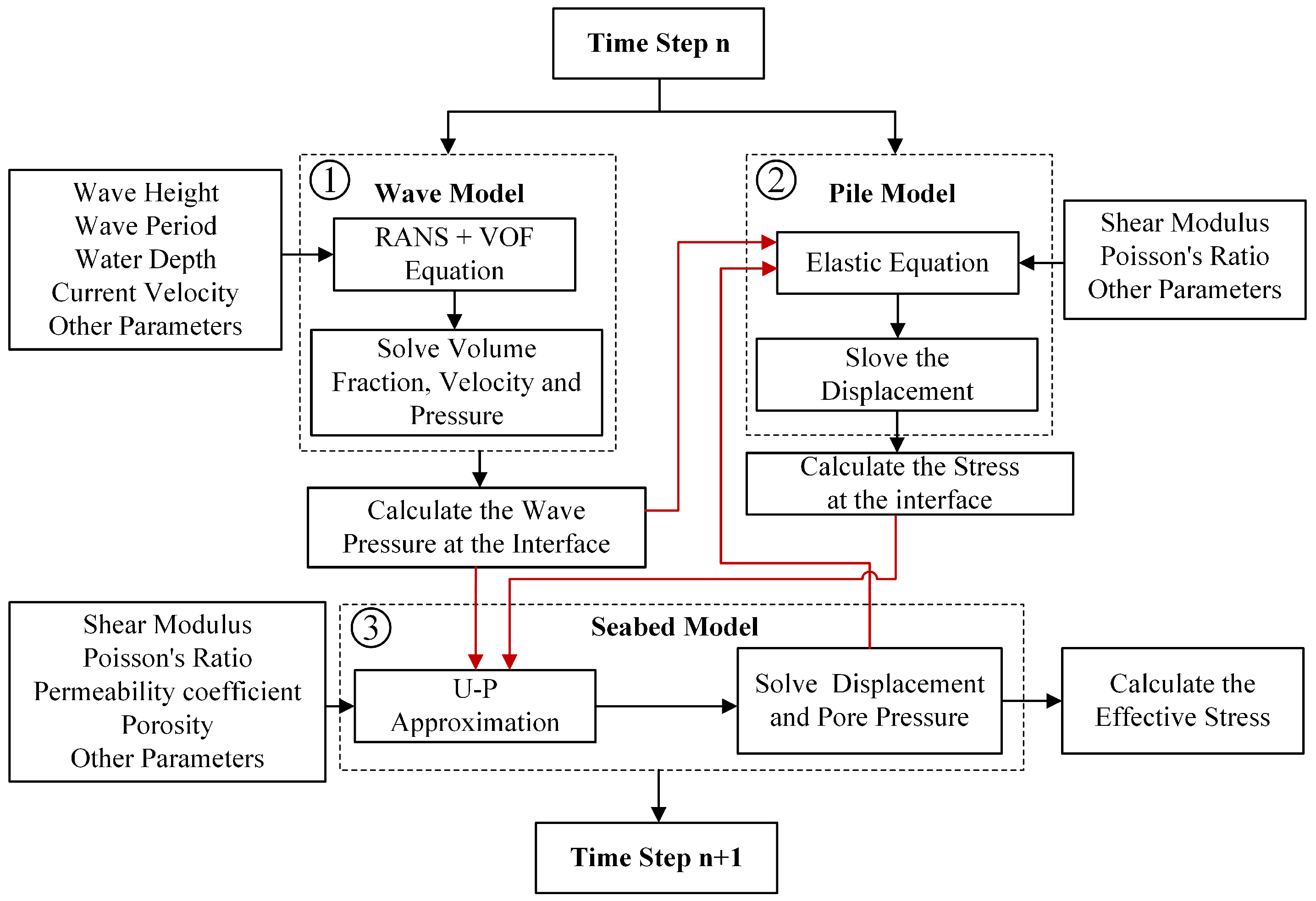

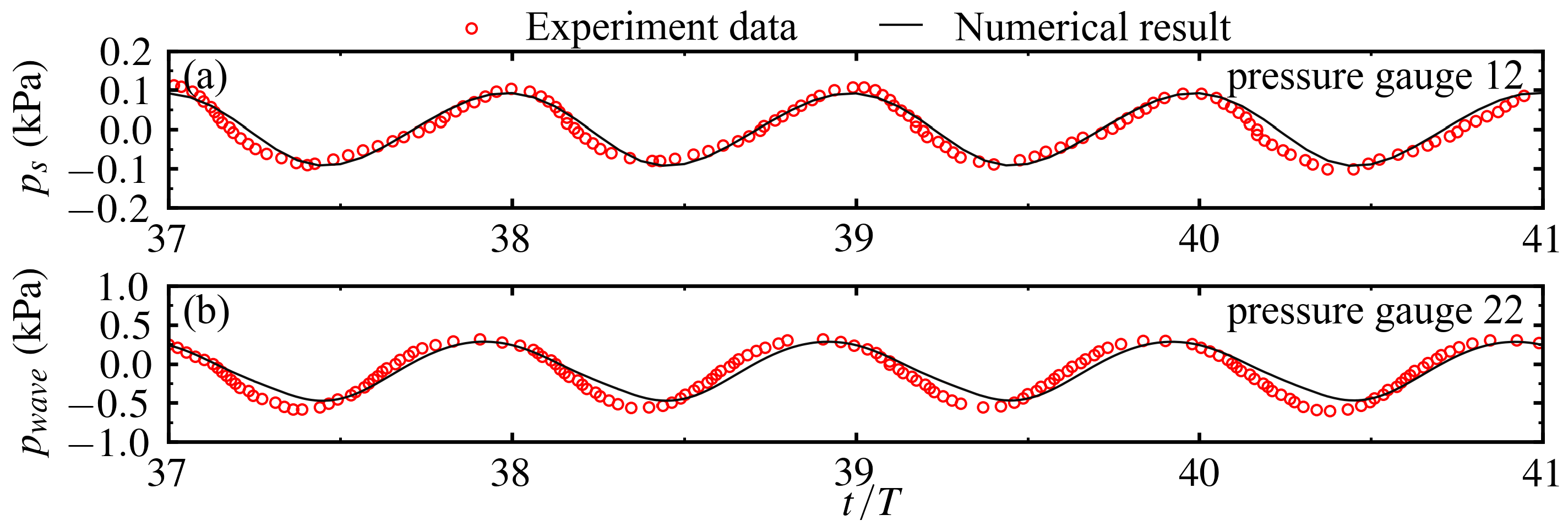
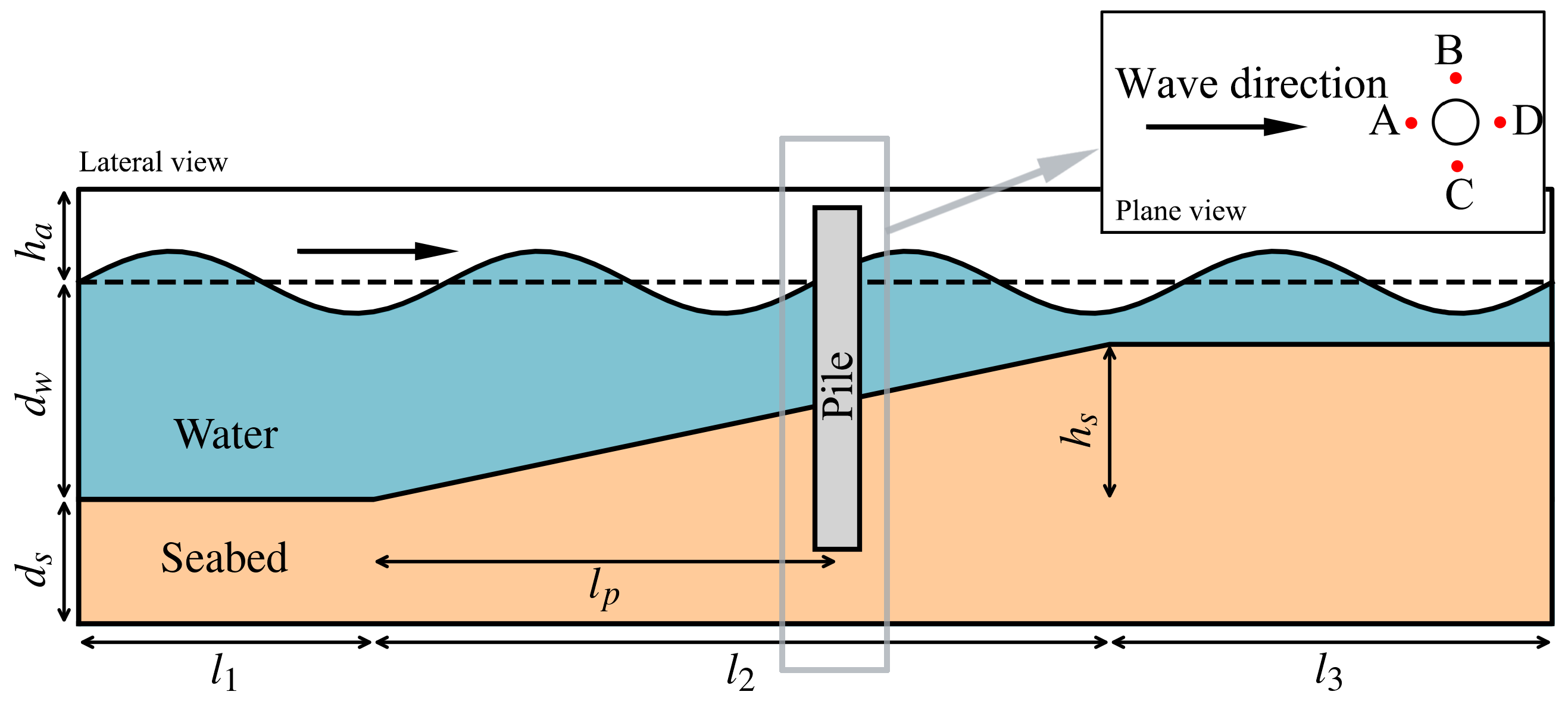

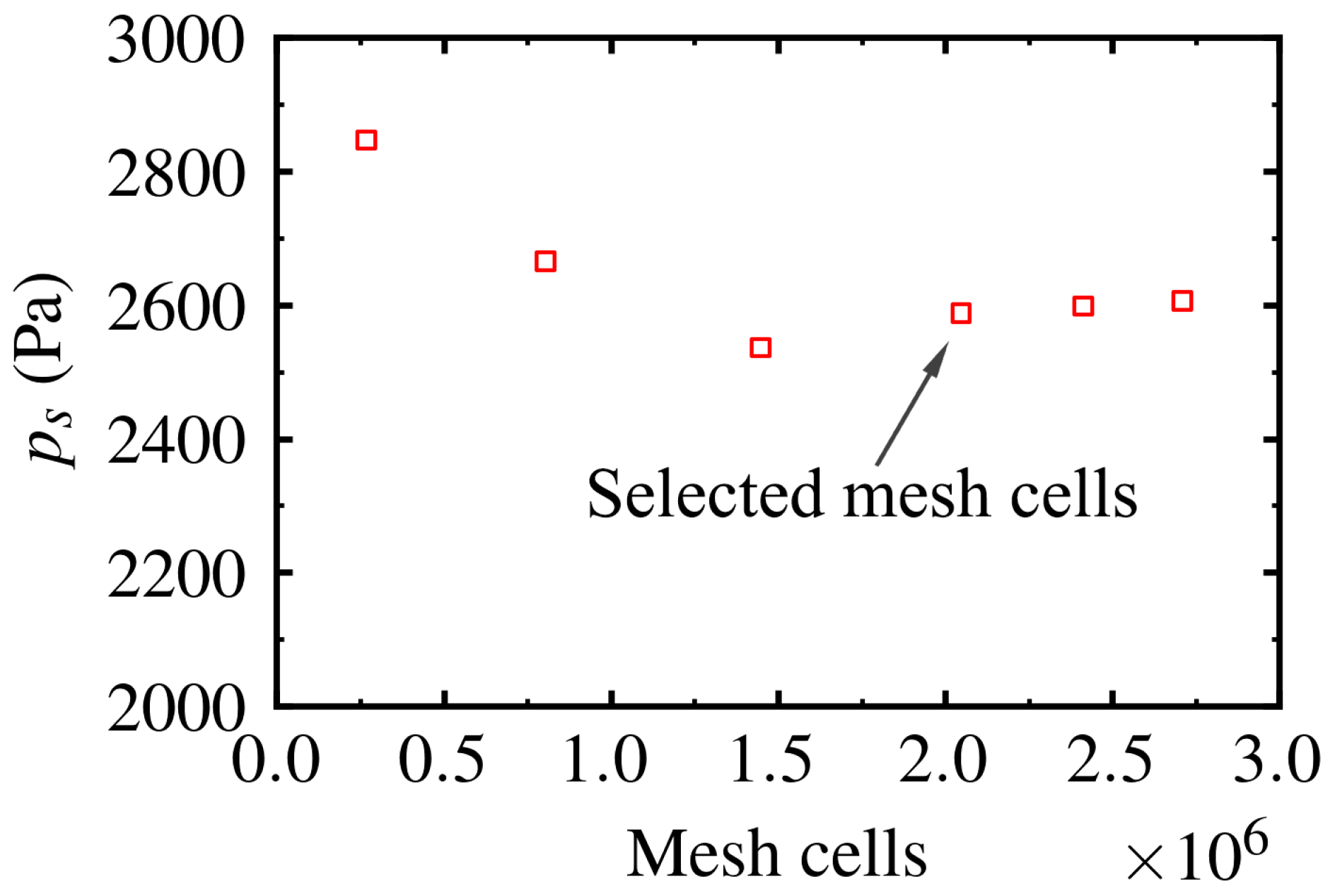
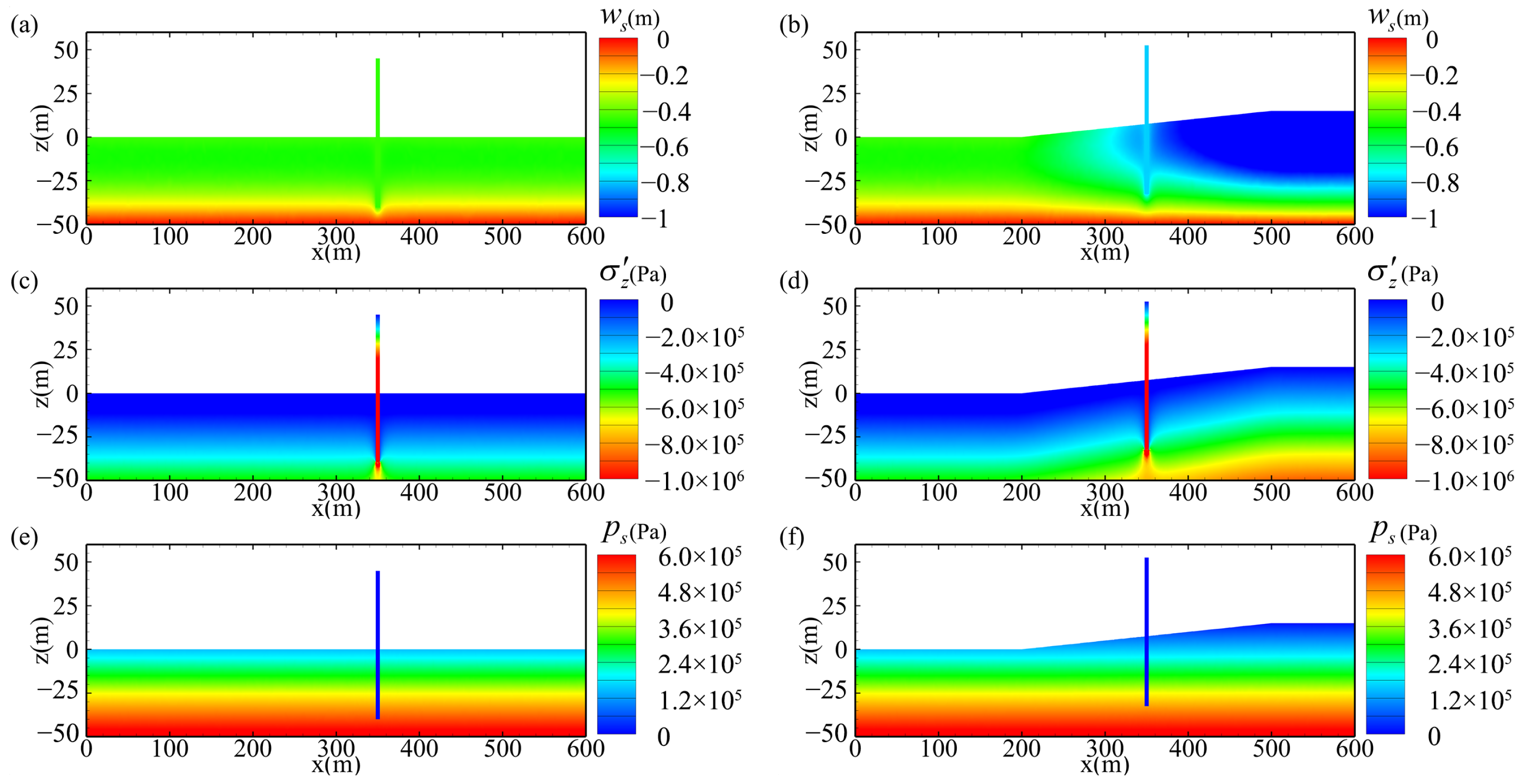
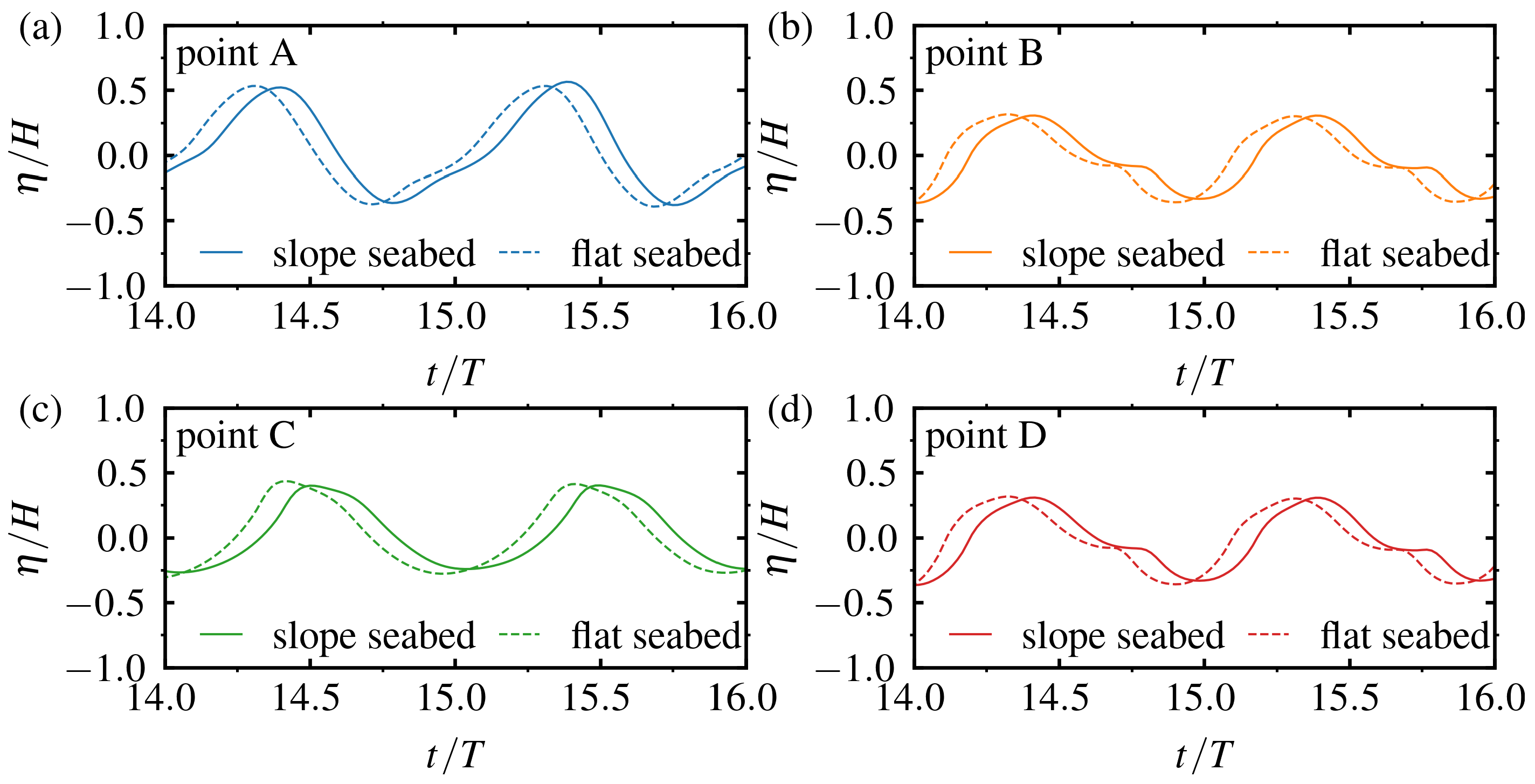
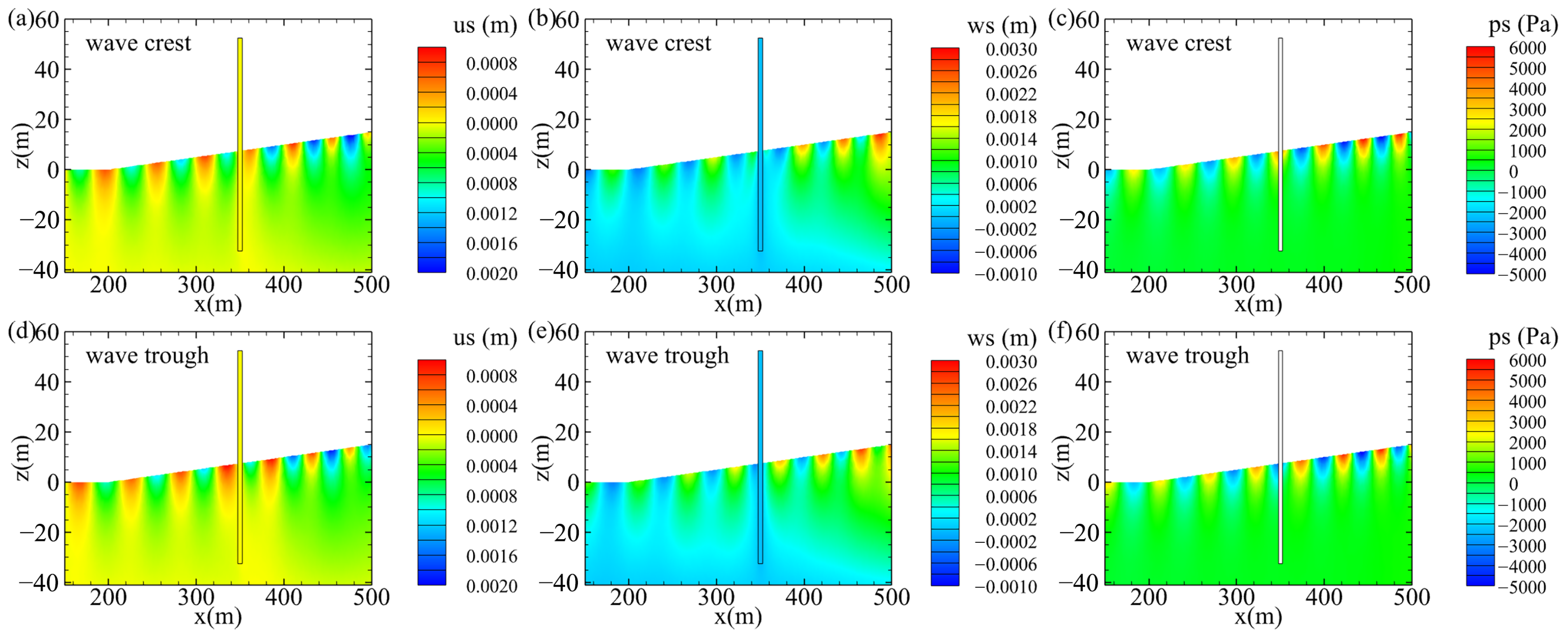
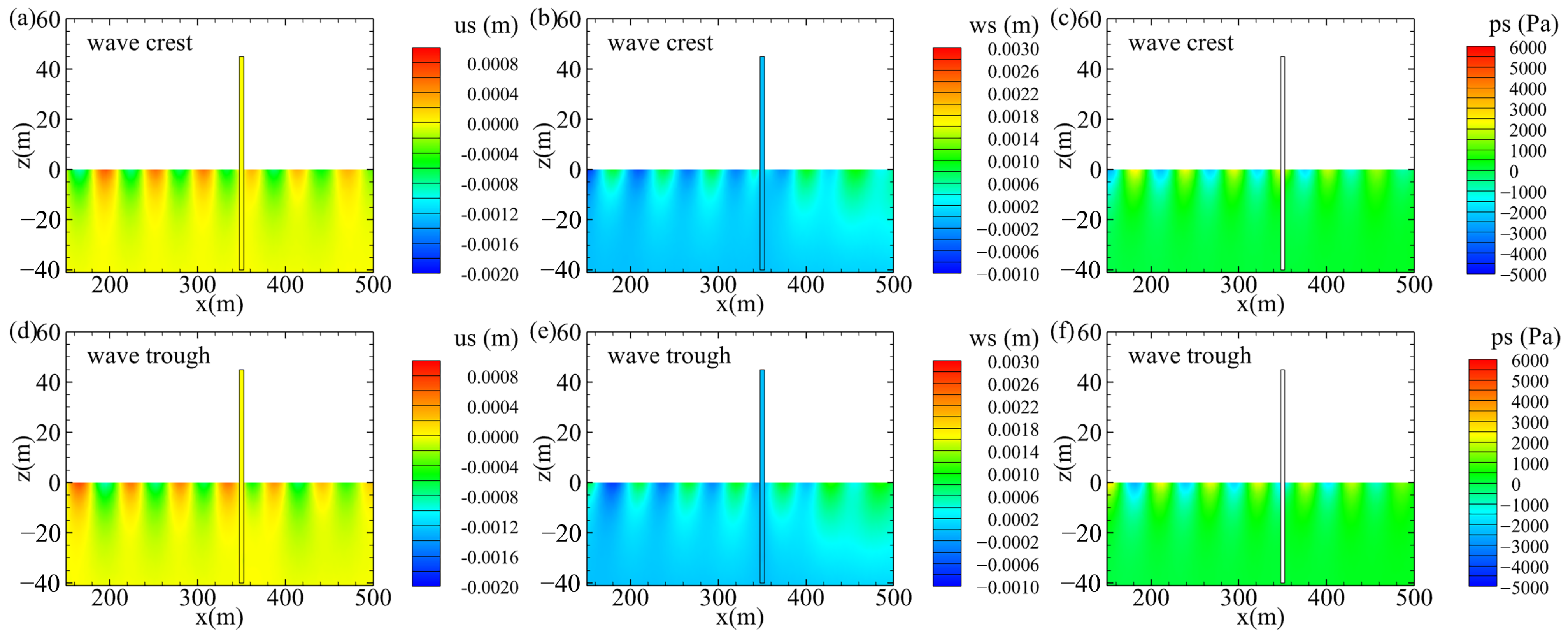



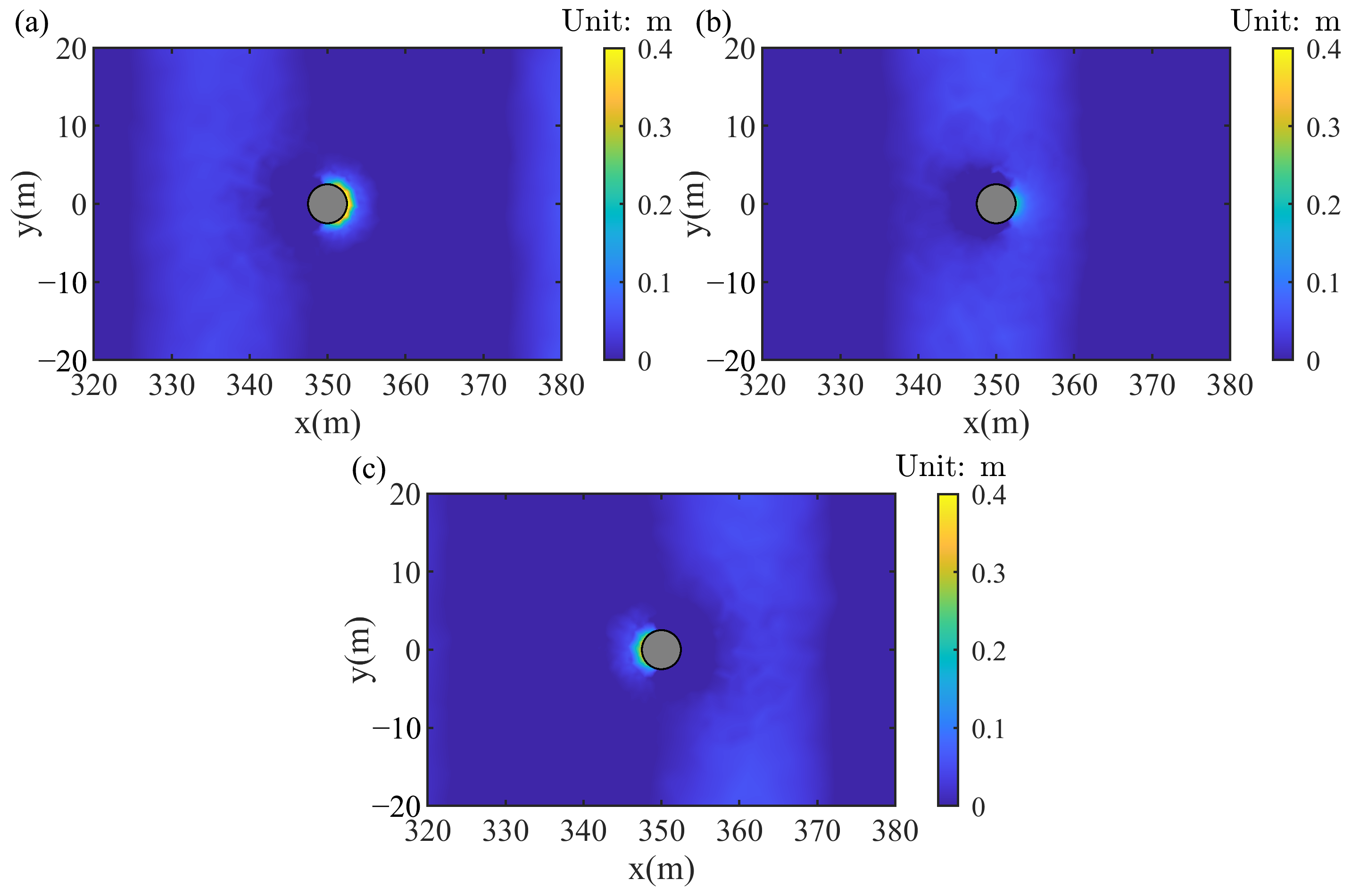
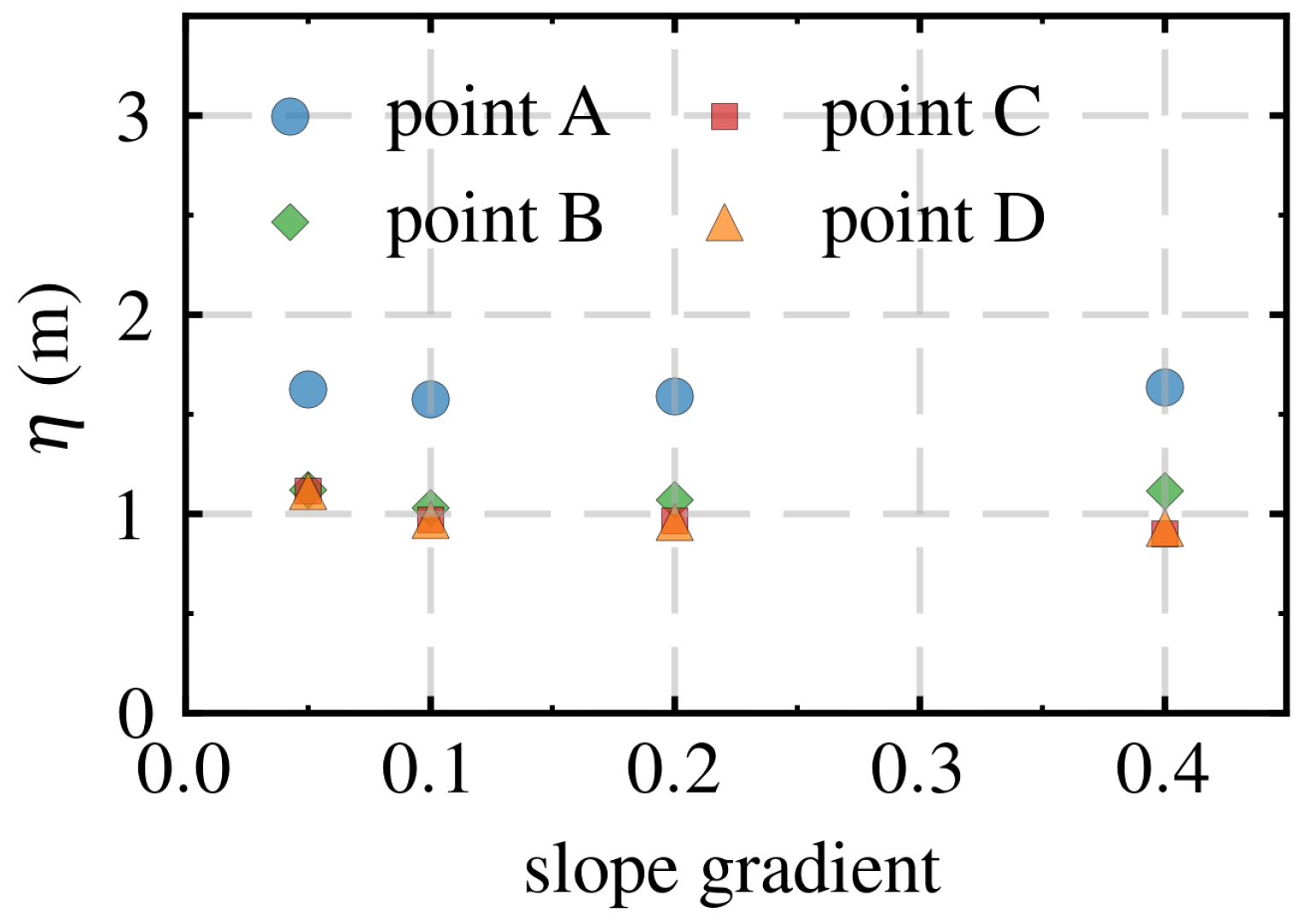
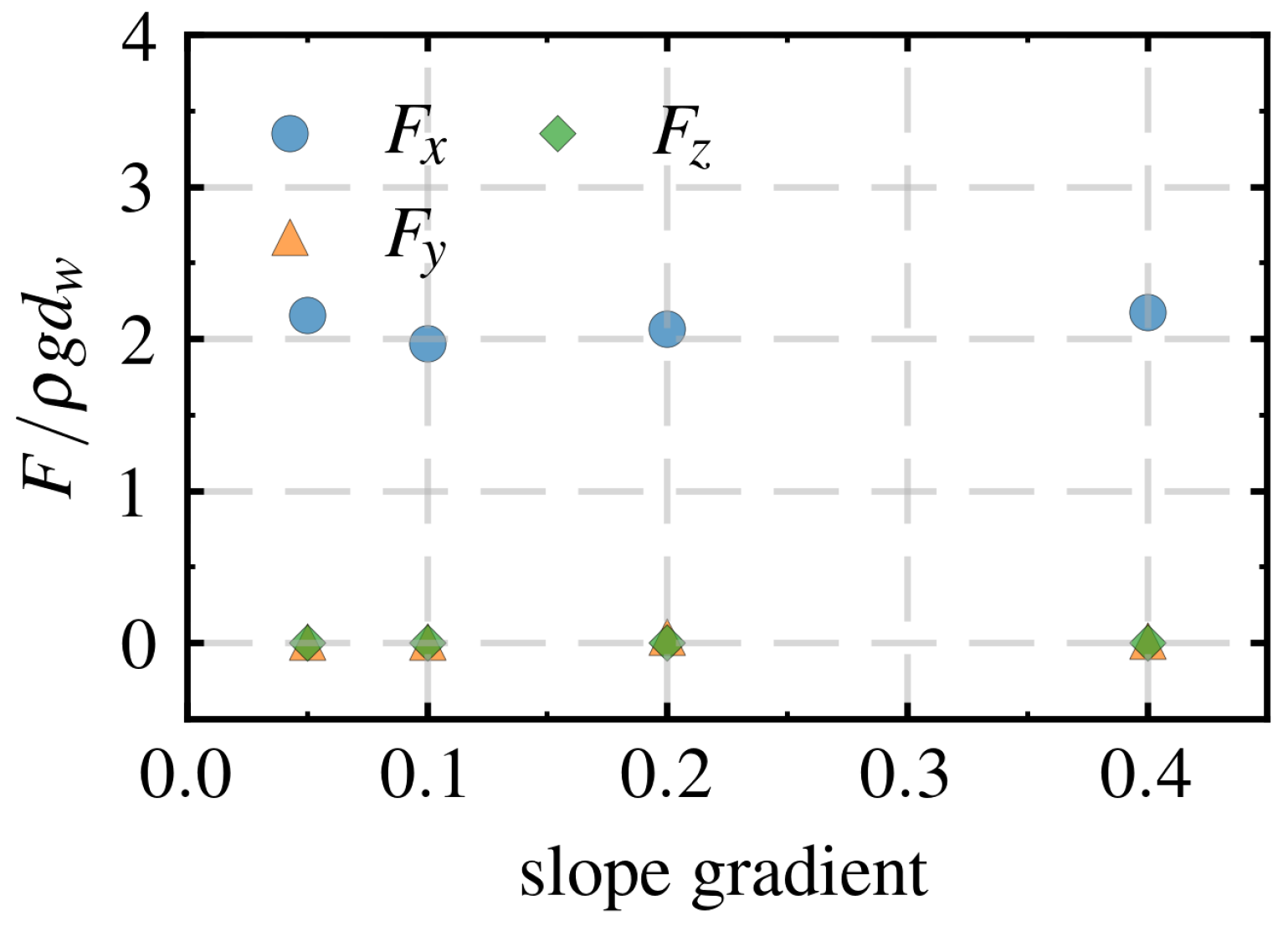
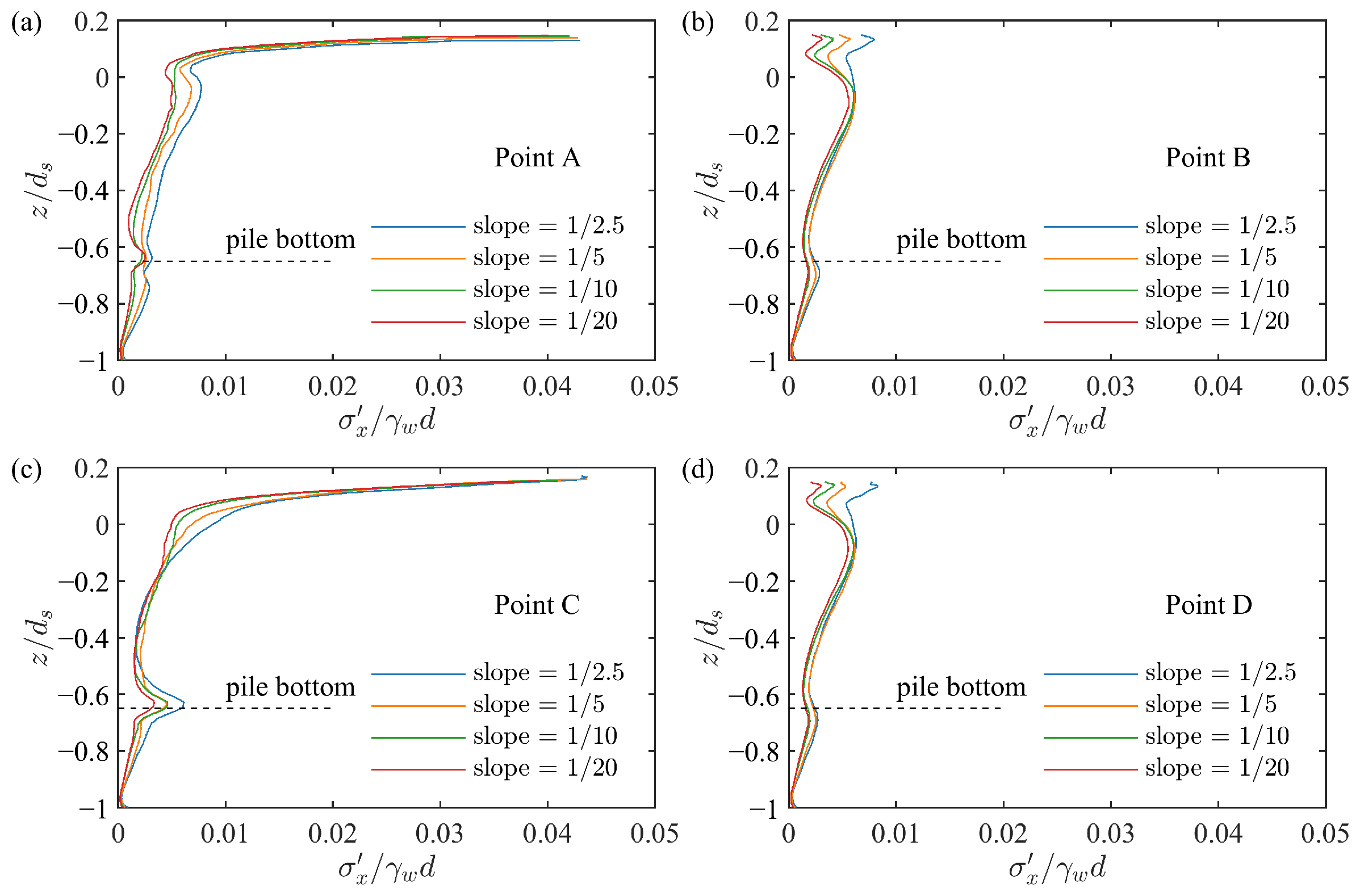
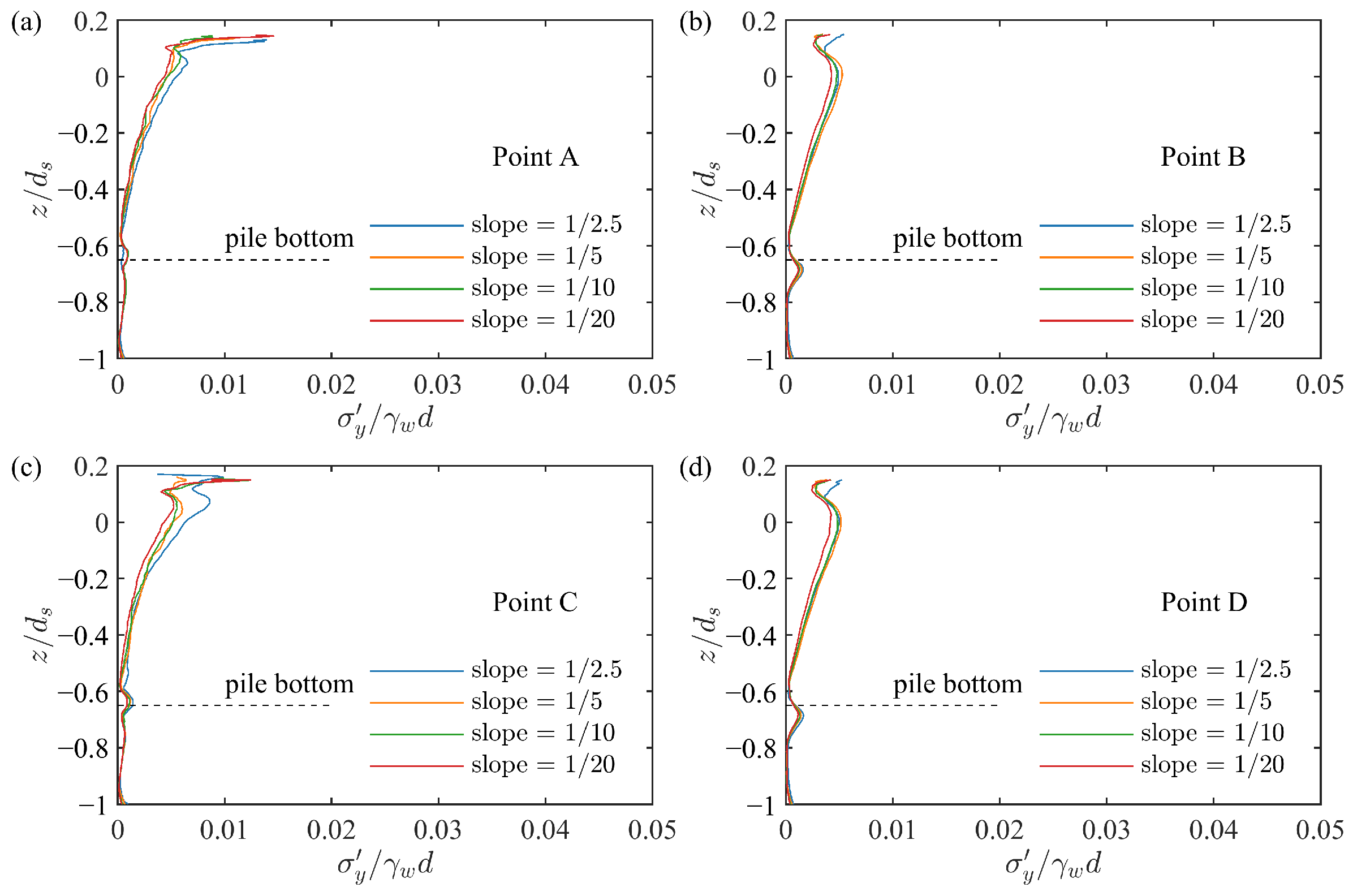
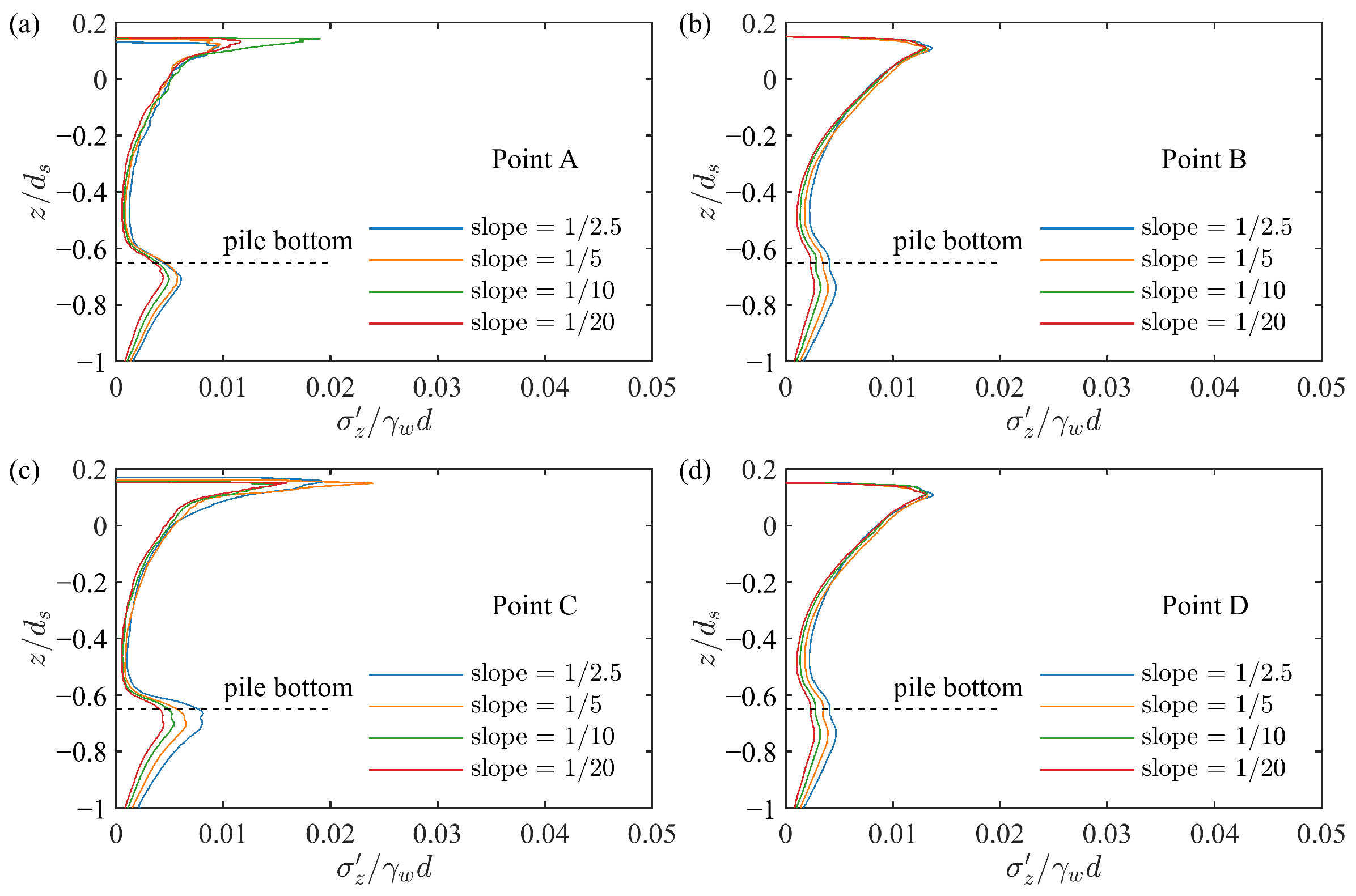


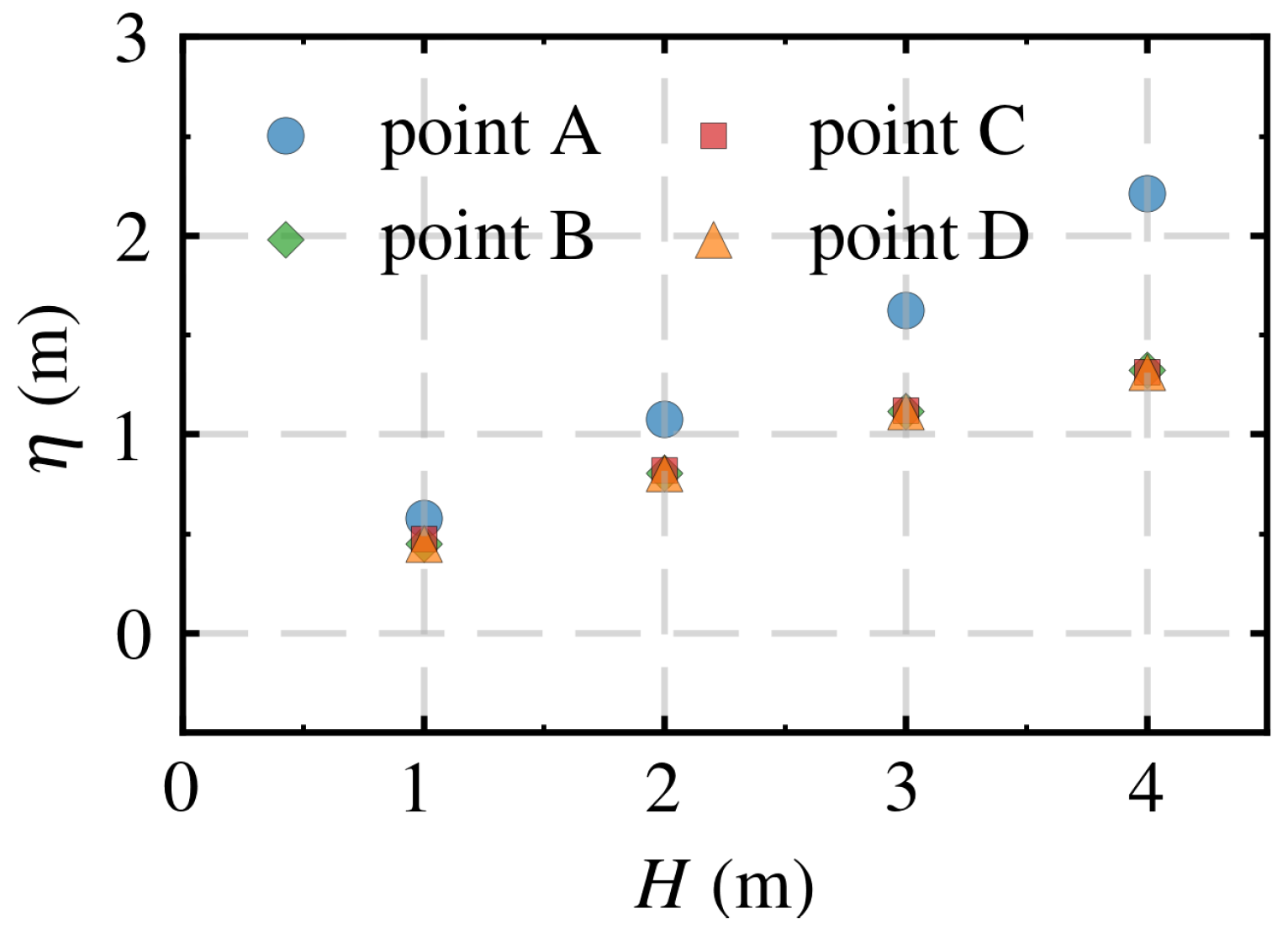
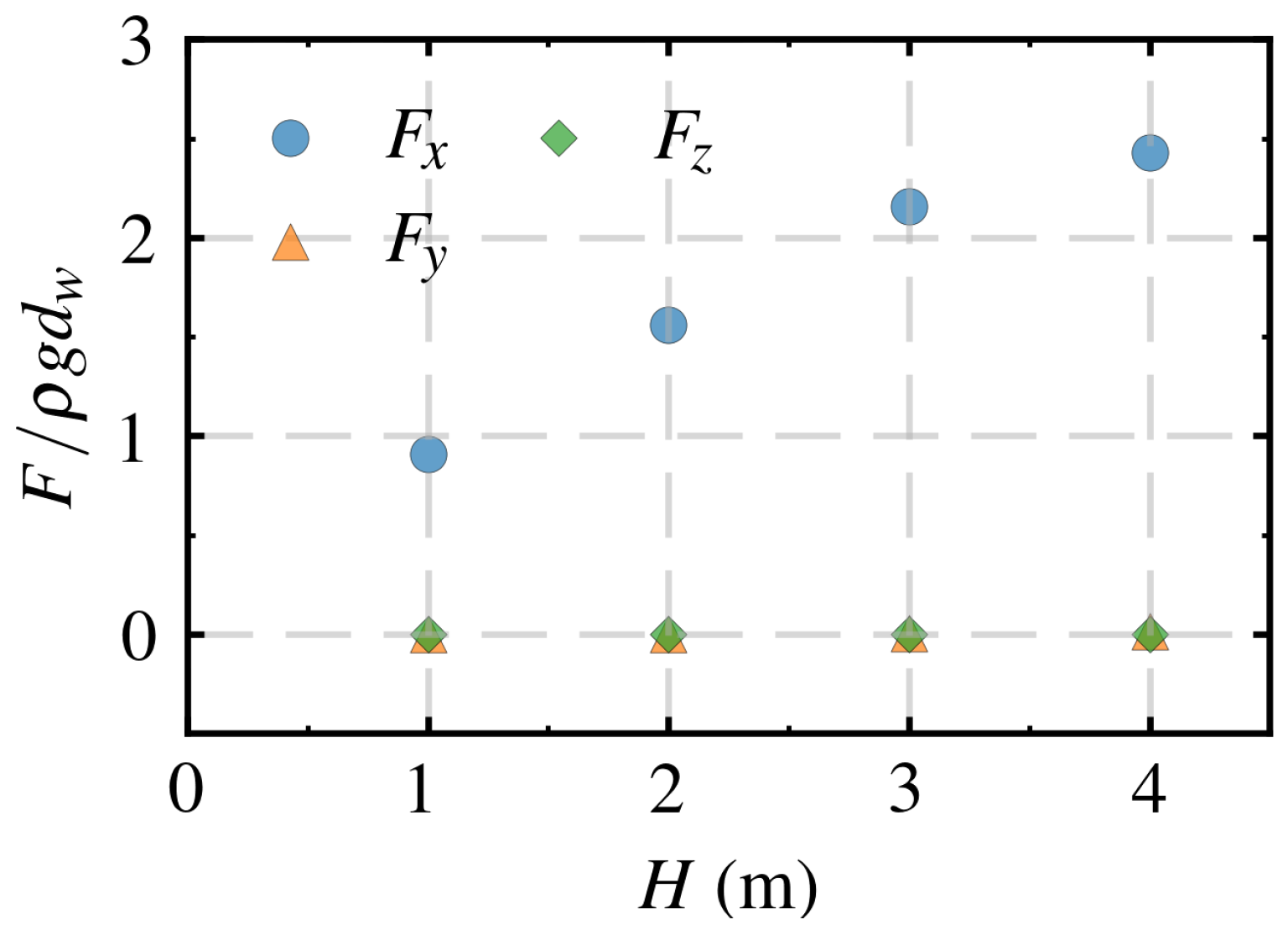

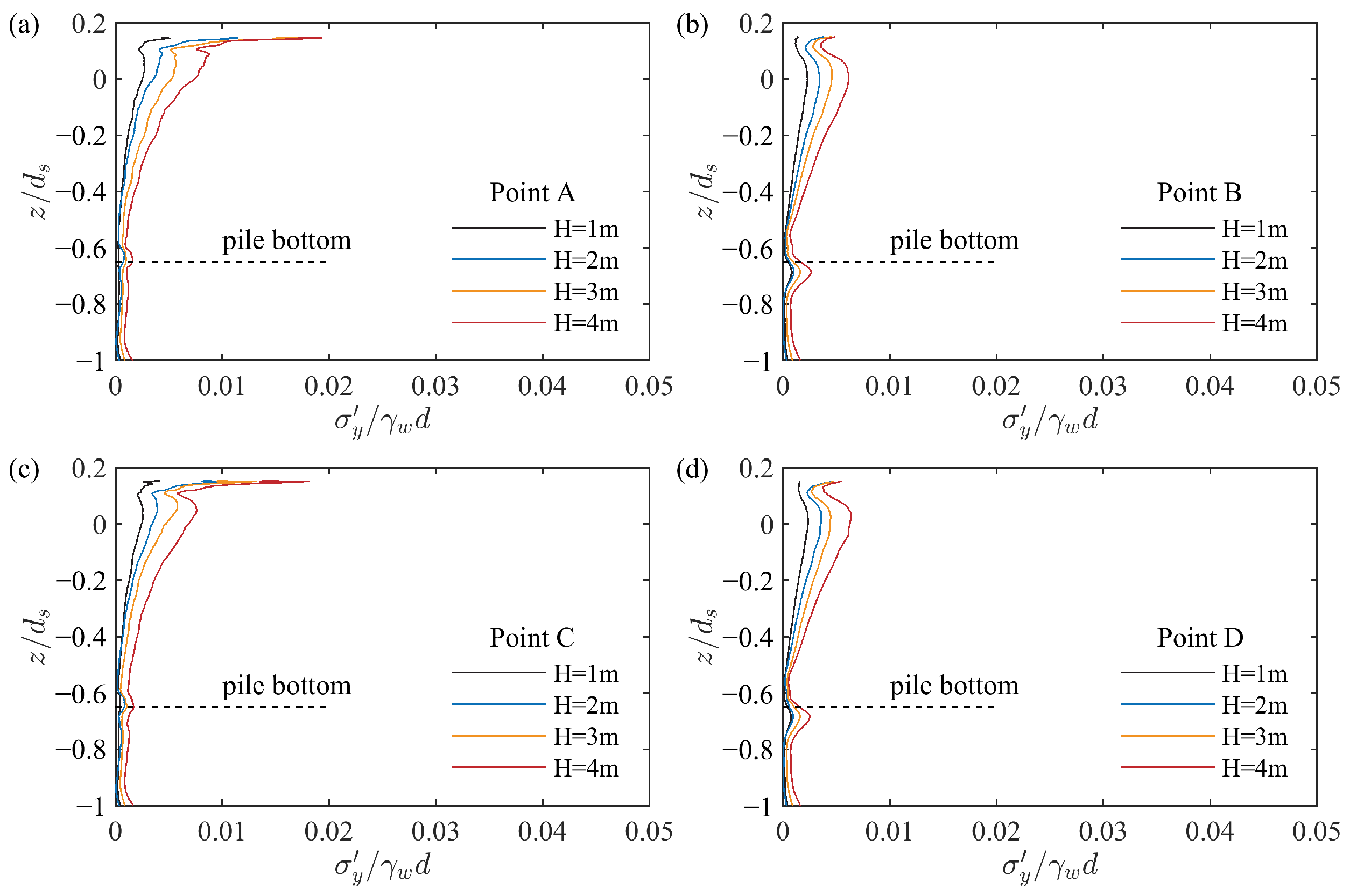
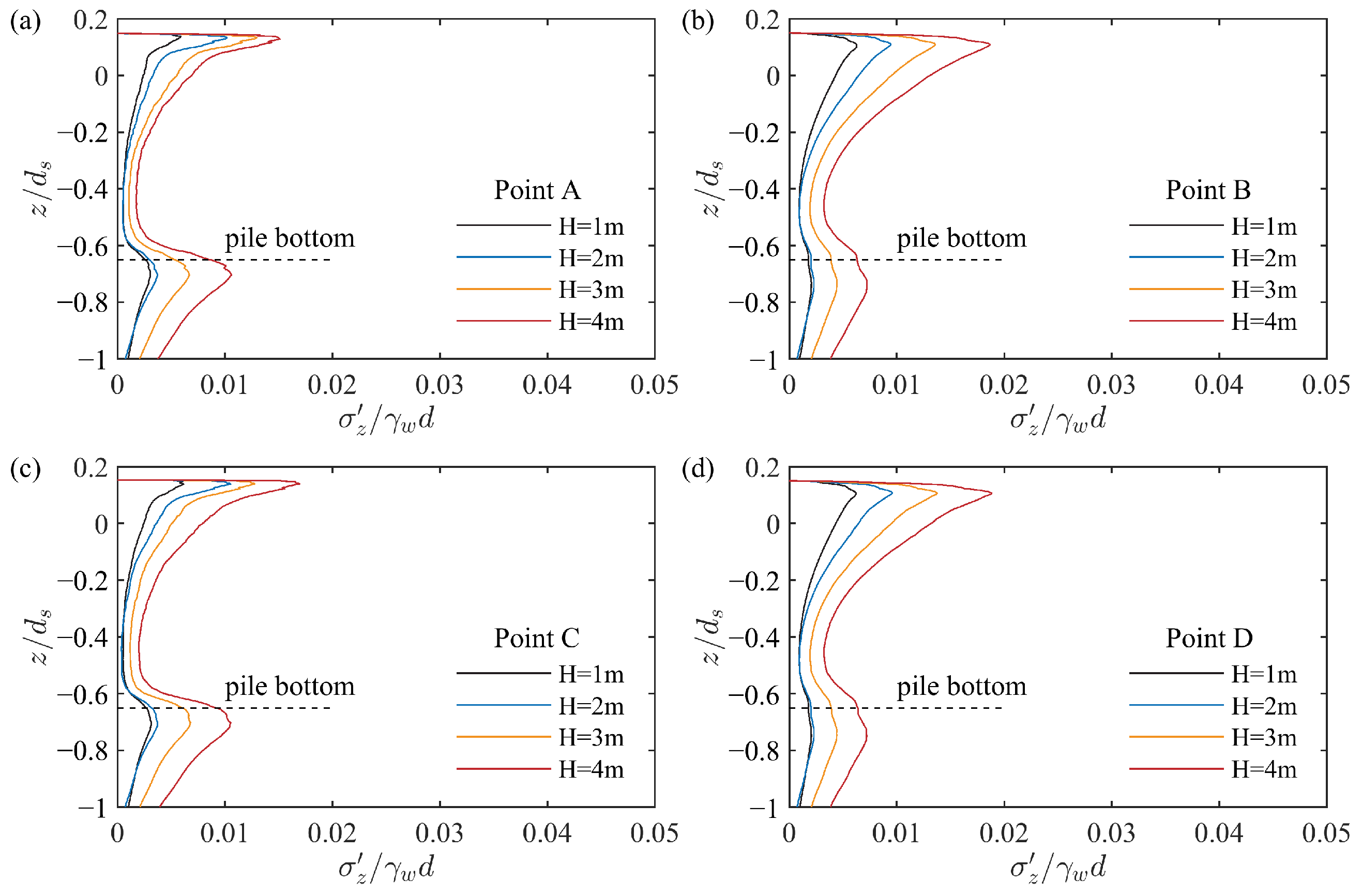

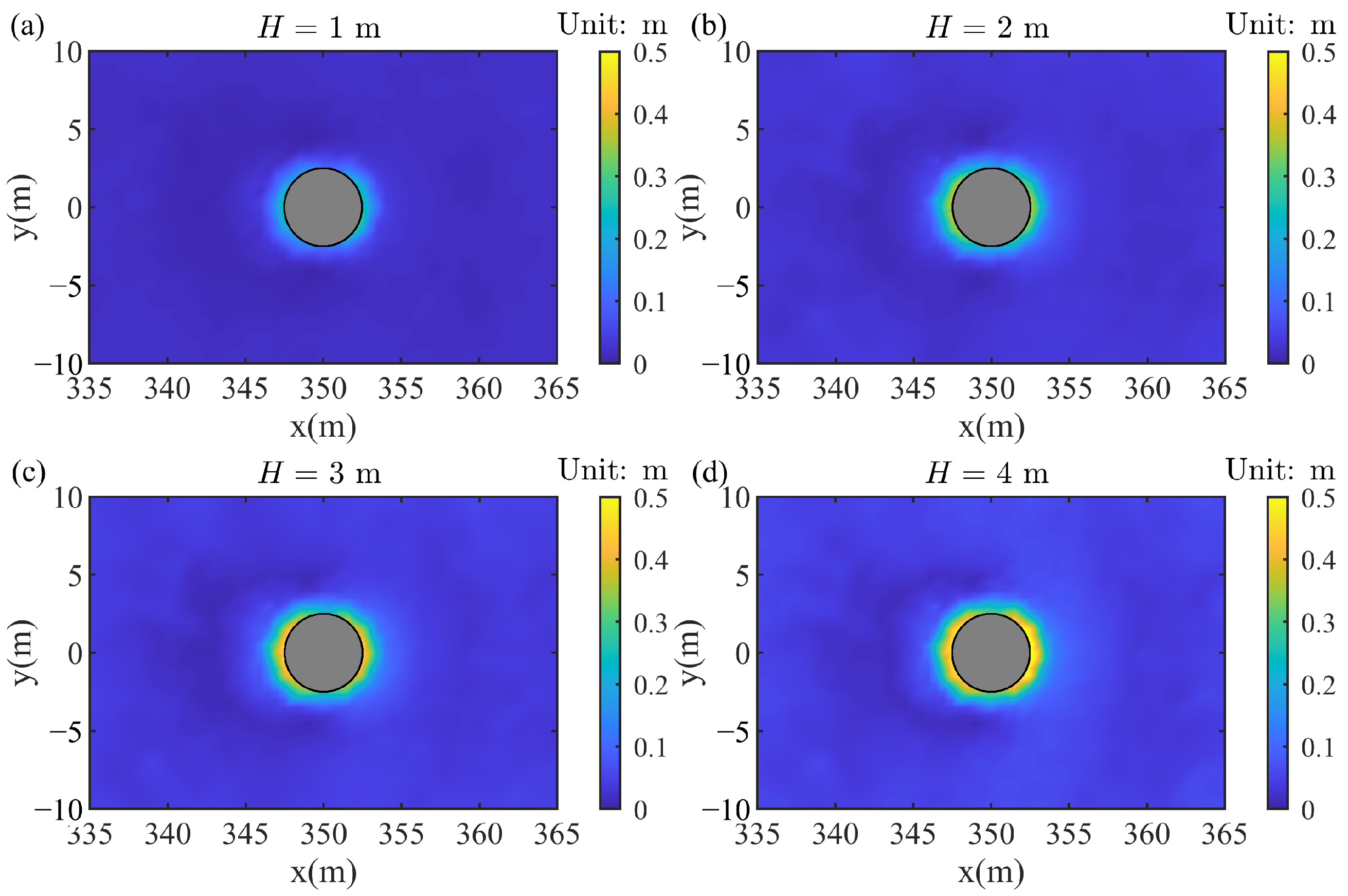
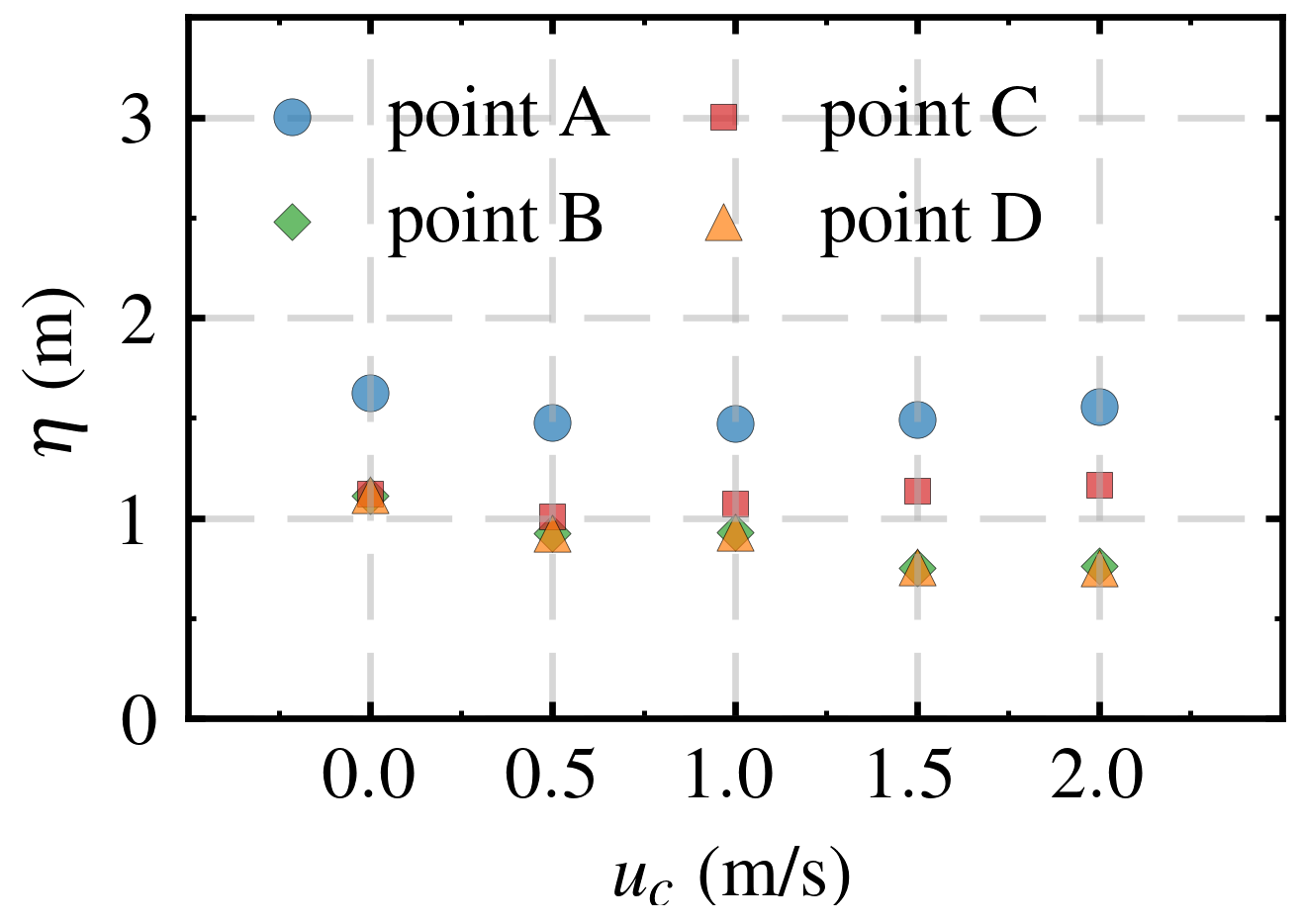
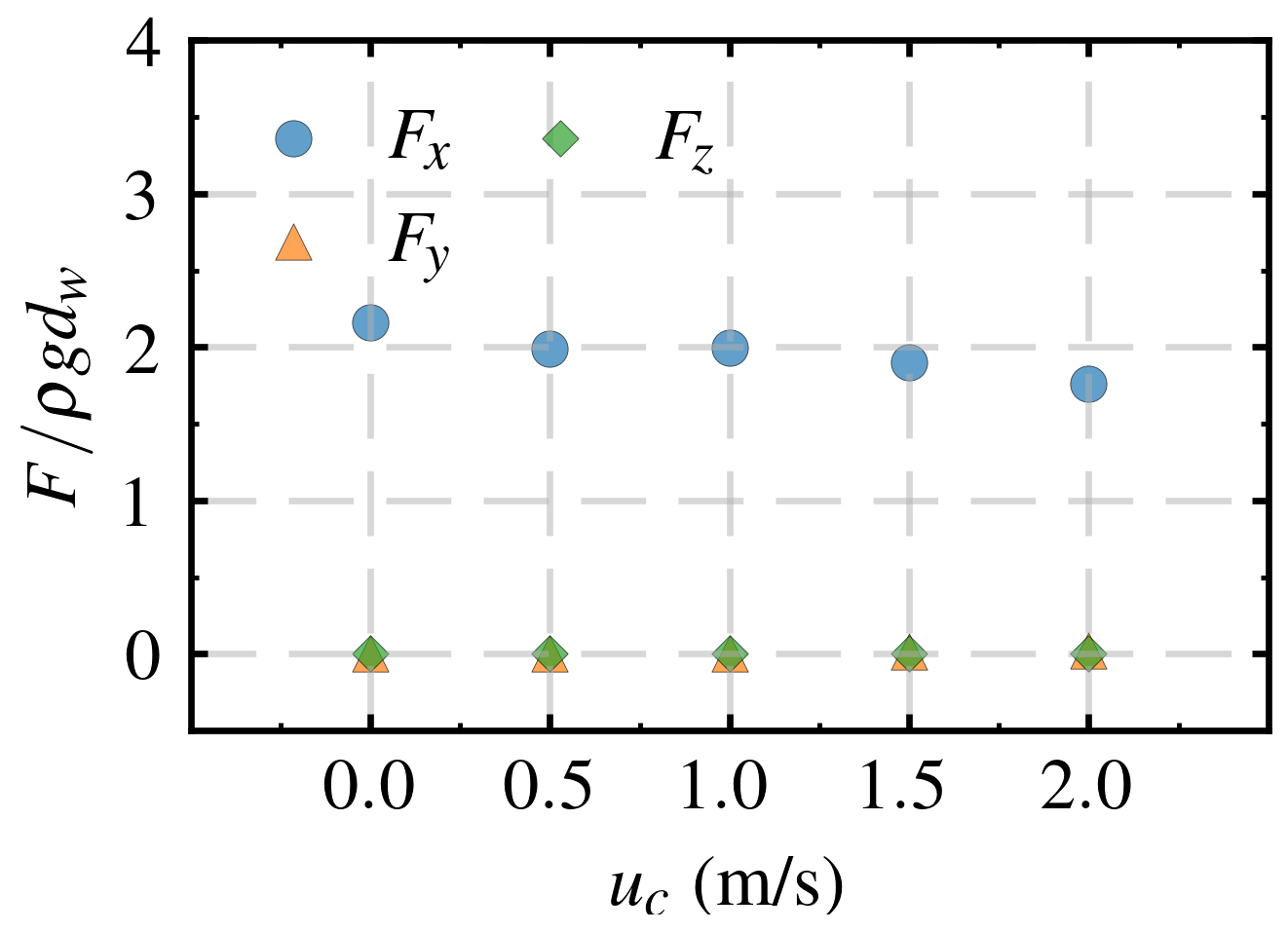
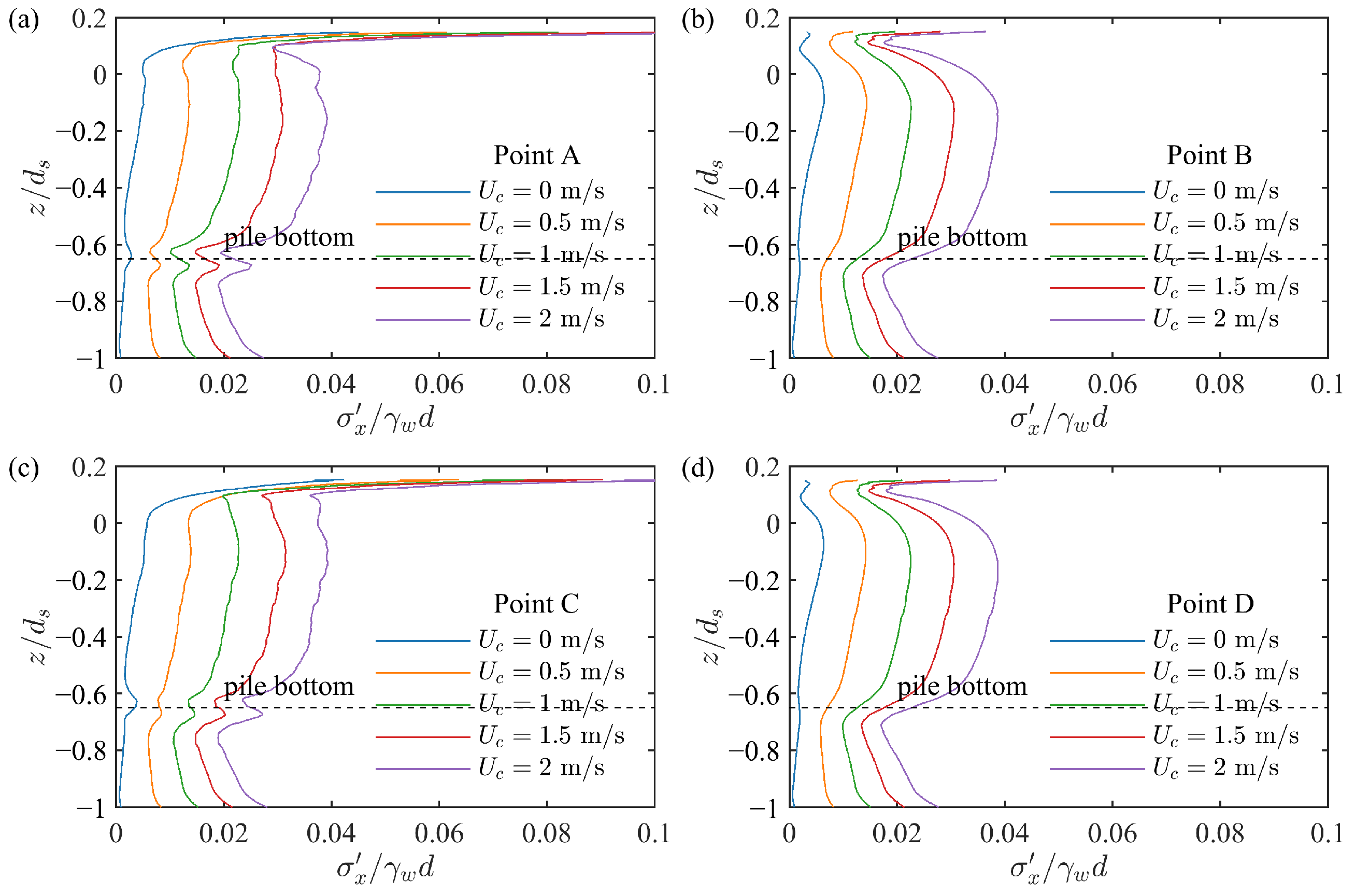

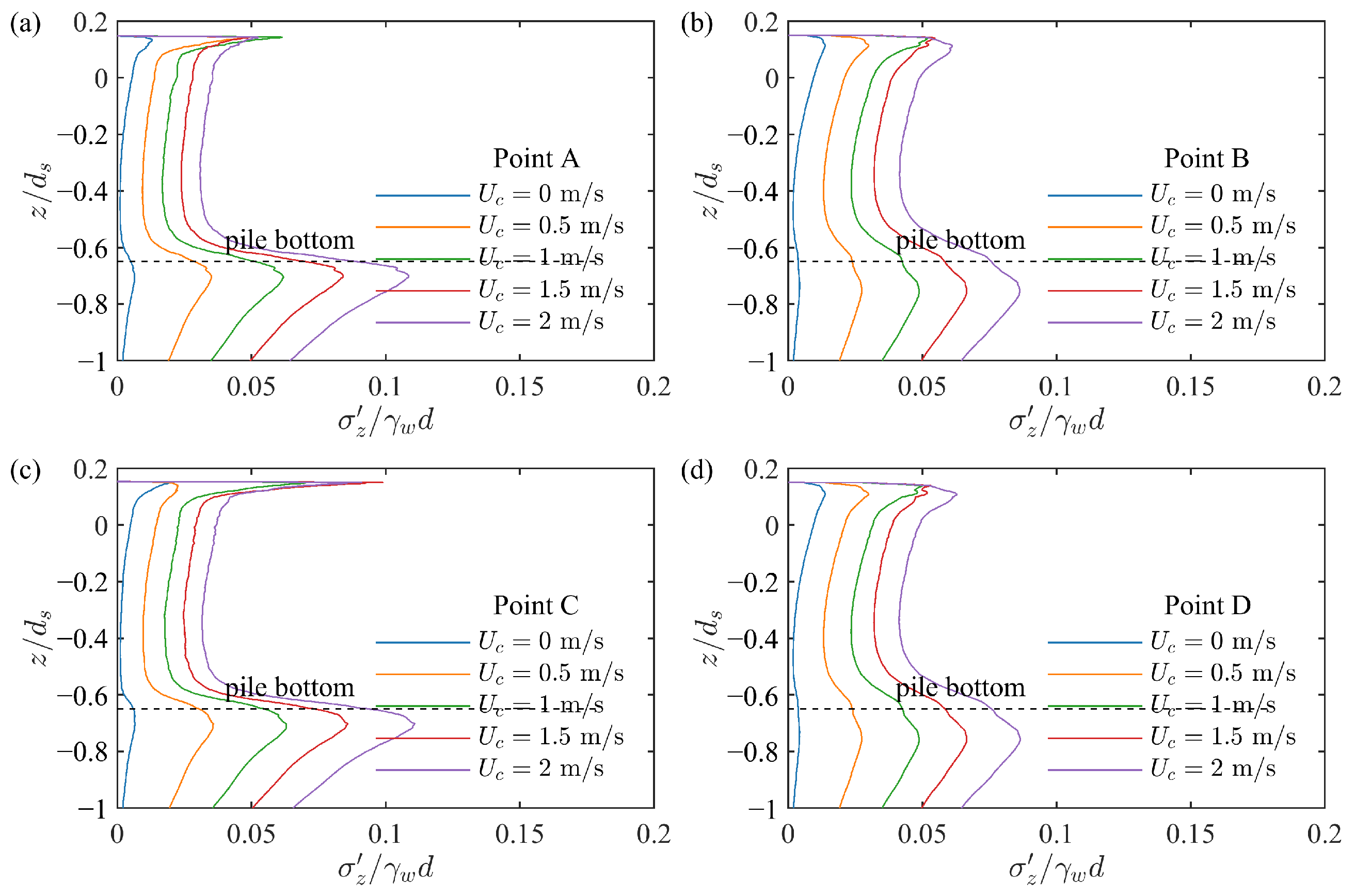
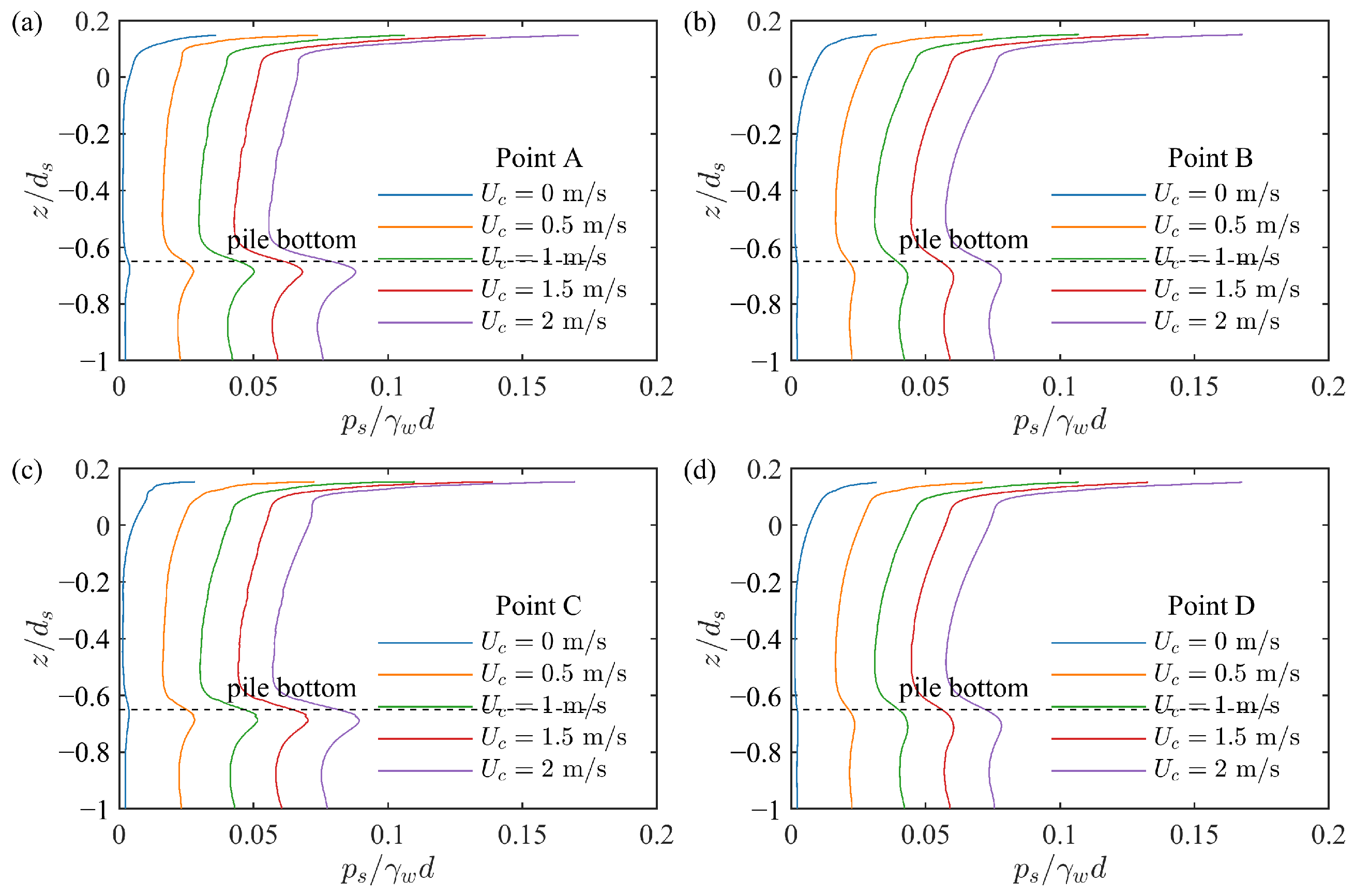
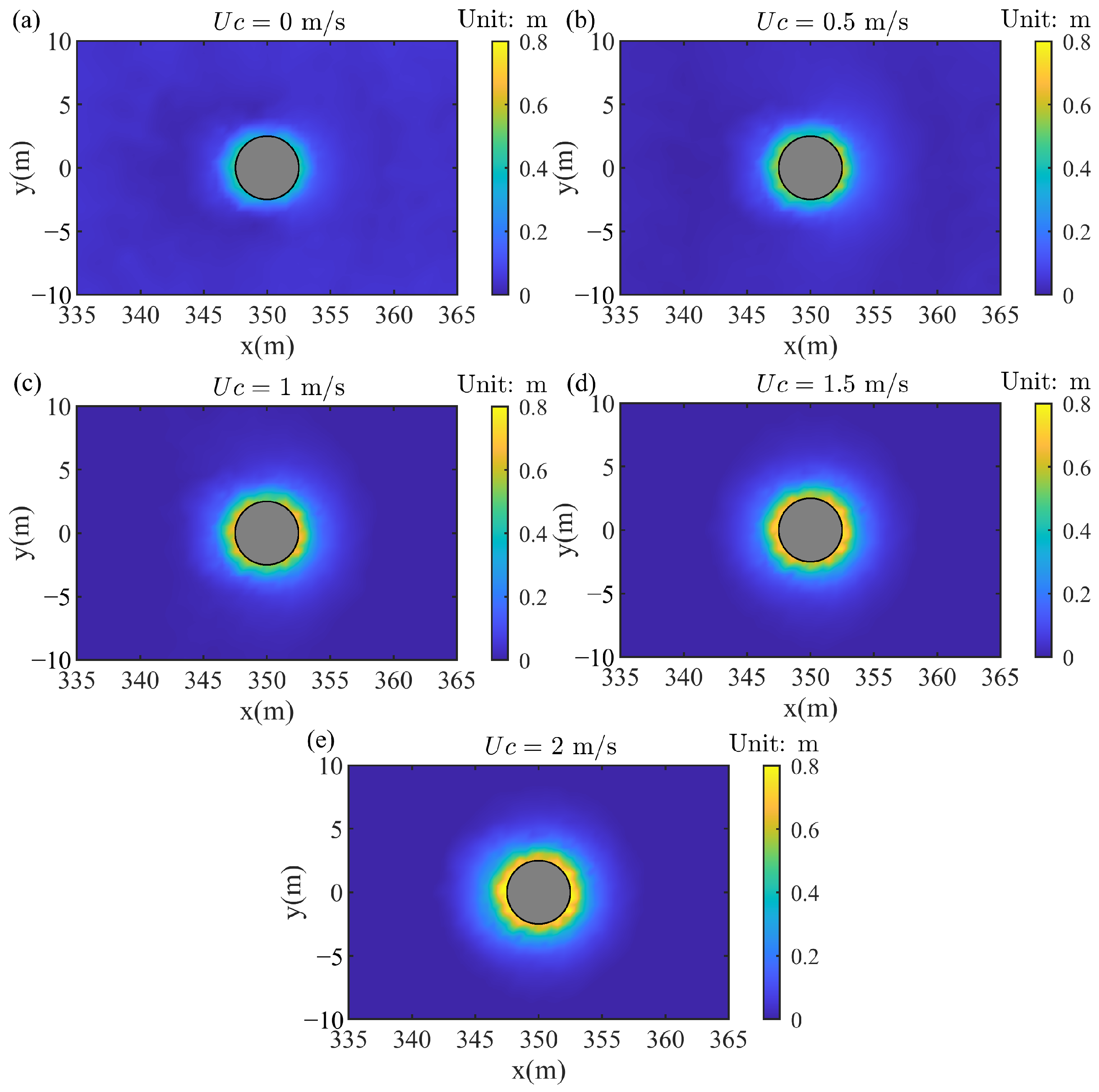
| Performance Rating | NSE | RSR |
|---|---|---|
| Very Good | 0.75–1.00 | 0.00–0.50 |
| Good | 0.65–0.75 | 0.50–0.60 |
| Satisfactory | 0.50–0.65 | 0.60–0.70 |
| Unsatisfactory | <0.50 | >0.70 |
| Parameter | Symbol | Unit | Value |
|---|---|---|---|
| pile diameter | m | 5 | |
| water depth | m | 20 | |
| air height | m | 10 | |
| seabed thickness | m | 20 | |
| seabed slope height | m | 15 | |
| seabed slope gradient | s | - | 1:20∼1:2.5 |
| off-seabed floor length | m | 200 | |
| seabed slope length | m | ||
| flat seabed length | m | 100 | |
| distance of pile from front of slope | m |
| Model | Parameters | Symbol | Unit | Value |
|---|---|---|---|---|
| wave | wave height | H | m | 3 |
| wave period | T | s | 6 | |
| current velocity | m/s | 0∼2 | ||
| seabed | shear modulus | Pa | ||
| permeability | m/s | |||
| particle density | kg/m3 | 2679 | ||
| porosity | n | - | 0.448 | |
| saturation | - | 0.99 | ||
| pile | shear modulus | Pa | ||
| particle density | kg/m3 | 4070 |
Disclaimer/Publisher’s Note: The statements, opinions and data contained in all publications are solely those of the individual author(s) and contributor(s) and not of MDPI and/or the editor(s). MDPI and/or the editor(s) disclaim responsibility for any injury to people or property resulting from any ideas, methods, instructions or products referred to in the content. |
© 2025 by the authors. Licensee MDPI, Basel, Switzerland. This article is an open access article distributed under the terms and conditions of the Creative Commons Attribution (CC BY) license (https://creativecommons.org/licenses/by/4.0/).
Share and Cite
Xu, C.; Gao, Y.; Xie, S.; Tong, L.; Tao, L.; Zhang, J. Variations in Pore Pressure and Effective Stress Induced by Wave and Current Around Monopile Foundations on Coral Reef Sloping Seabeds. Water 2025, 17, 1621. https://doi.org/10.3390/w17111621
Xu C, Gao Y, Xie S, Tong L, Tao L, Zhang J. Variations in Pore Pressure and Effective Stress Induced by Wave and Current Around Monopile Foundations on Coral Reef Sloping Seabeds. Water. 2025; 17(11):1621. https://doi.org/10.3390/w17111621
Chicago/Turabian StyleXu, Chao, Yuan Gao, Shoupeng Xie, Linlong Tong, Liming Tao, and Jisheng Zhang. 2025. "Variations in Pore Pressure and Effective Stress Induced by Wave and Current Around Monopile Foundations on Coral Reef Sloping Seabeds" Water 17, no. 11: 1621. https://doi.org/10.3390/w17111621
APA StyleXu, C., Gao, Y., Xie, S., Tong, L., Tao, L., & Zhang, J. (2025). Variations in Pore Pressure and Effective Stress Induced by Wave and Current Around Monopile Foundations on Coral Reef Sloping Seabeds. Water, 17(11), 1621. https://doi.org/10.3390/w17111621






